Which of the Following Choices Is a Component of the Reviewing Process?
Editorial Workflow
In this chapter, yous will follow a submission throughout the workflow, from kickoff submission to final publication.
This PKP School video provides an overview of the editorial workflow in OJS 3.3. To watch other videos in this series, visit PKP's YouTube aqueduct.
The workflow is divided into 4 stages:
Submission: This is where new submissions land while being assigned to Section Editors and considered for moving into the Review stage.
Some submissions are clearly inappropriate and never brand information technology beyond this stage.
This PKP Schoolhouse video explains the steps the Editor takes to assign a new submission to a Section Editor. To lookout man other videos in this series, visit PKP'due south YouTube channel.
Review: This is where the peer review happens, besides as whatever revisions required by the author.
Some submission will non pass review and cease here. Those that are accepted movement to the side by side stage.
Copyediting: Accustomed articles motion to this stage, where they are improved by the piece of work of a copyeditor. Authors can be given the opportunity to review the copyedits.
Production: Once the copyedits are completed and approved, the submission moves to this stage. In Production, the copyedited files are converted to galleys – HTML, XML, PDF, etc. Again the writer has the opportunity to proofread the galleys. One time everyone is satisfied, the submission is scheduled for publication in a futurity result.
This PKP School video explains the Production stage. To watch other videos in this series, visit PKP'southward YouTube channel.
Tasks #
Your Tasks are available from the top left bill of fare of your Dashboard. Note the number "i" in the prototype below. This indicates that there is currently 1 chore in your listing.
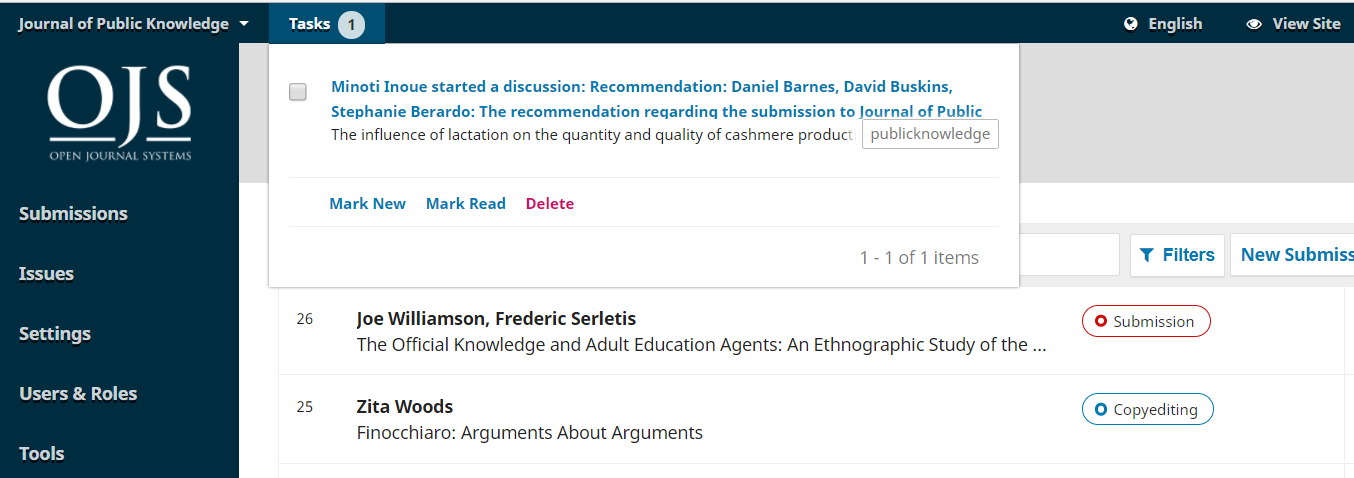
Tasks provide a quick look at items that need your attending. Bold entries are unread, and unbold entries have been read.
Use the checkbox to marker tasks for deletion (the link is available at the bottom of the listing).
Submission Notifications #
When an author makes a new submission to your periodical, the author and all contributors volition receive an email acknowledging their submission and an editor will be automatically emailed a notification of the new submission. In some cases an editor will be automatically assigned to the submission. Which editor(s) receive the notification or are automatically assigned will depend on how you have fix up your journal.
- If in that location is but one user assigned to an Editor or Journal Manager part, that user will be automatically assigned and notified.
- If 1 or more Section Editors are assigned to the section the submission was made in, they will exist automatically assigned to the submission and notified.
- If one or more than Section Editors are assigned to a category the submission was made in, they will be automatically assigned to the submission and notified.
Y'all can also configure OJS so that a copy of the notification electronic mail is sent to the periodical's primary contact set in Periodical Settings, or to some other accost.
To enable copies of submission acknowledgment email to be sent to the primary contact or another address:
- In the Periodical Manager's dashboard, go to Settings > Workflow > Submissions
- Roll down to Notification of Author Submissions
- Check off the box next to "Send a re-create to the primary contact, identified in the Journal Settings." if you wish for a copy to be sent to the primary contact electronic mail, and/or
- Enter the email you would like to have a re-create sent to in the text field.

If y'all want to disable submission acknowledgement emails entirely, you can do then by disabling the Submission Ack email template from the list of prepared e-mail templates. To learn more most disabling and enabling email templates, refer to Disable email templates in the Workflow Settings chapter.
Users can as well alter their individual notification settings from their own contour nether View Profile > Notifications.
Submission Dashboard #
When you log into your Dashboard, yous can discover agile submissions either from your Tasks, or from i of the queues (My Queue, Unassigned, All Active, and Archives). The counter gives you an overview of how many full items are in each queue.
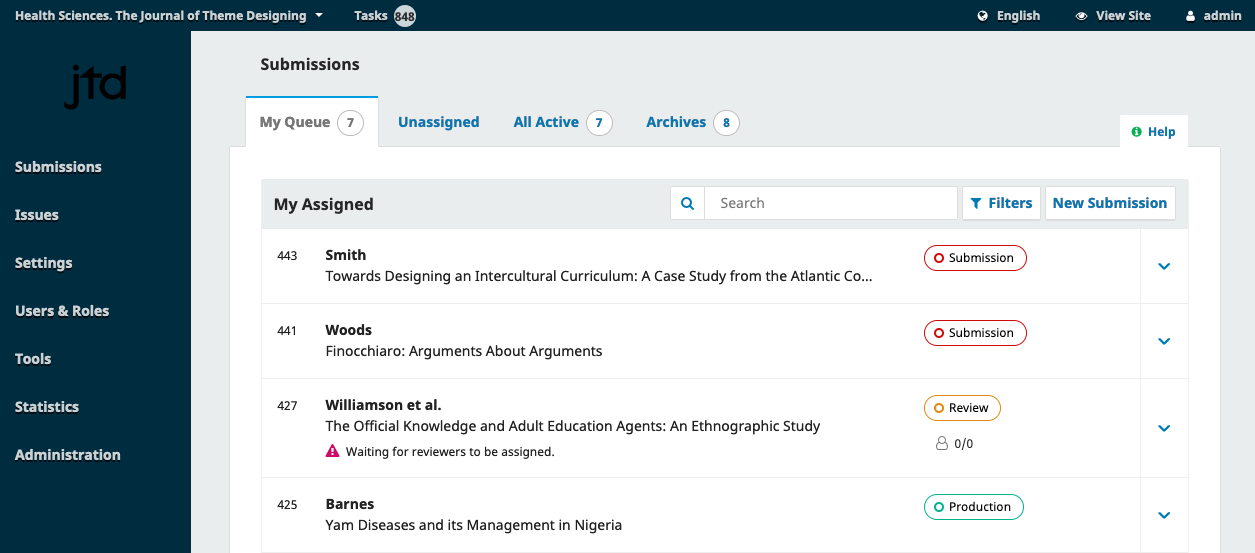
My Queue #
My Assigned: This panel includes submissions added to sections where you are a section editor or to your own submissions if you are also an writer with this periodical.
The Search tool for each queue can sometimes exist helpful in tracking down submissions.
The Filter tool allows you to limit your browsing to specific weather condition for faster searching. Depending on their function, editorial roles volition exist able to filter by the following:
-
Status: select from incomplete, overdue, and inactive for 30 days
-
Stages: select from submission, review, copyediting, and product
-
Sections: this choice is simply available if more than 5 sections exist. After you begin entering text, the filter will auto-advise. For example, filter by manufactures or reviews
-
Assigned editor(s): but Journal Managers and Periodical Editors have this filter pick. Like sections, this is a textbox which will auto-suggest a Section Editor, Journal Editor, or Invitee Editor's proper name as you start to blazon it, then display all articles assigned to the editor.
-
Assigned effect: only journal managers tin filter by unpublished issues, but editors and administration volition exist able to filter by published issues. This field is instance-sensitive and require exact match. For all-time results, search by twelvemonth or championship, rather than volume or number. This filter is mostly used if the assignment of a submission to an result is done in an early on phase of the editorial process.
Some filters let multiple selections; users tin can filter by more than one editor, section or issue. Filters are applied with OR weather, so when a user selects to filter by Editor A and Editor B, all submissions volition be returned that are assigned to editor A OR editor B.
When using multiple filters, the AND condition will be applied between filters. For example, when filtering by Review Stage AND Editor A, merely submissions assigned to Editor A in the review stage volition be returned.
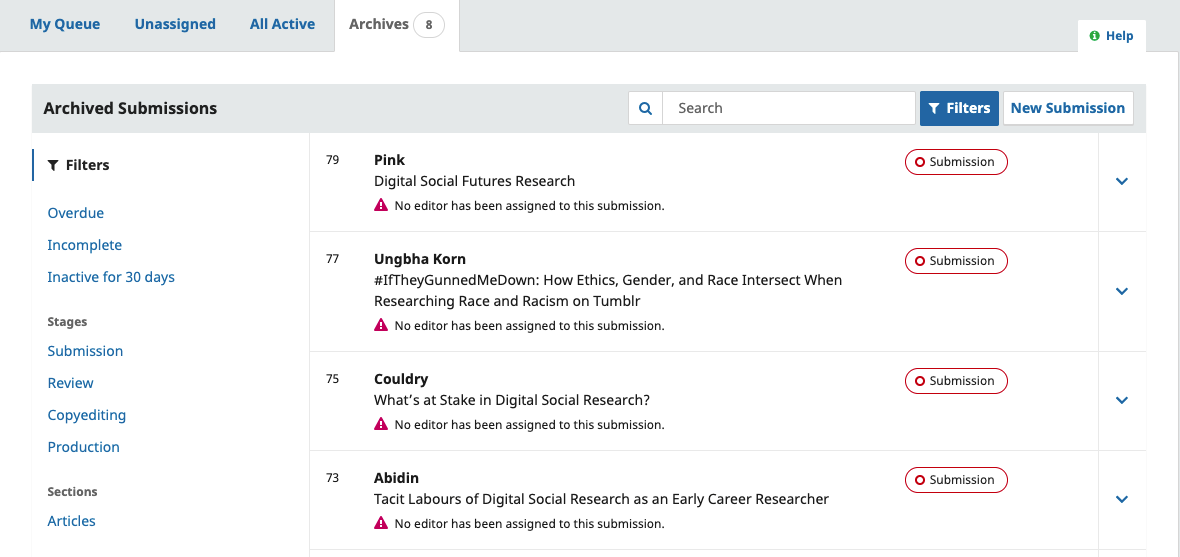
Note that you can use the blue arrows to the right of each submission to reveal more details, including how many reviews are outstanding, new discussions, and more. It also reveals buttons to take you to the submission record, view the activity log and notes, and to delete the submission.
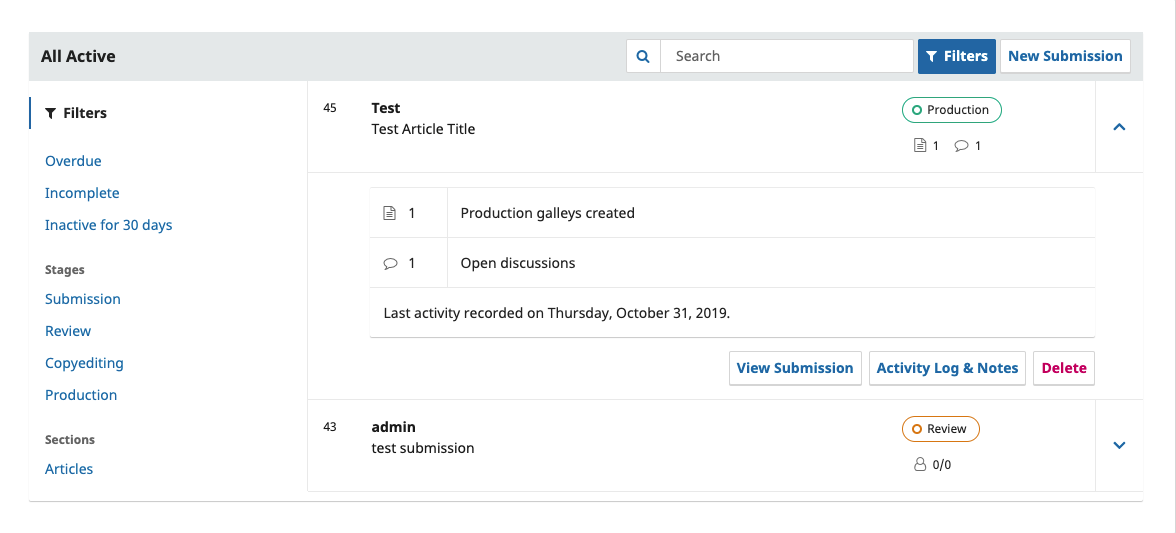
Unassigned #
This console includes submissions added to sections without department editors.
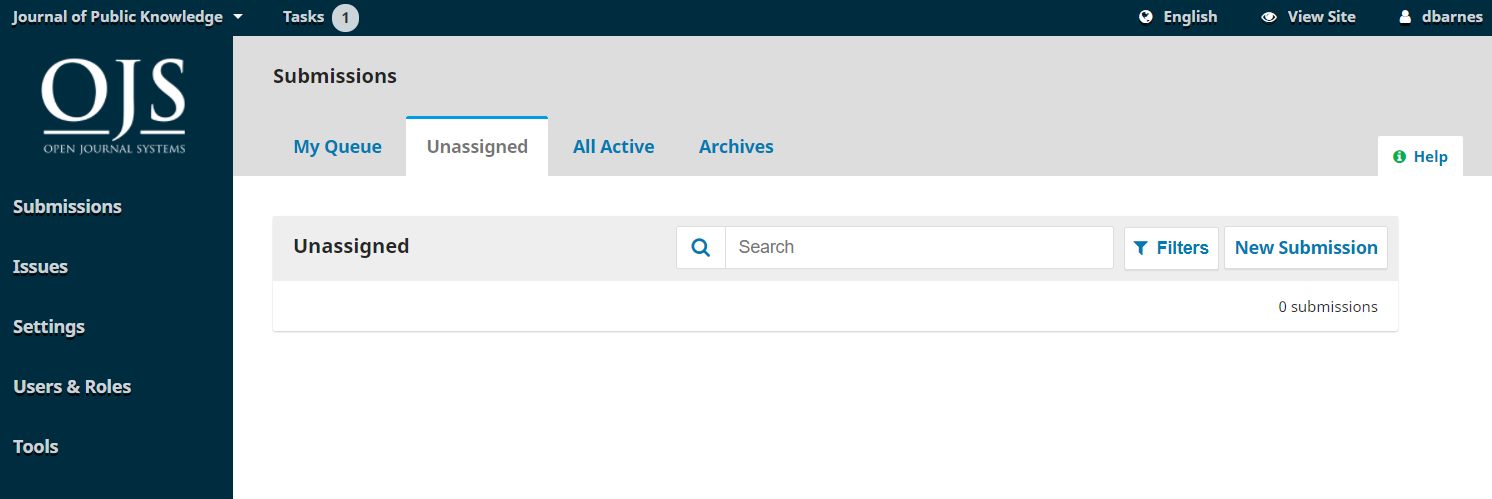
In the higher up example, there are no unassigned submissions, so the panel is empty.
All Active #
This department includes a list of all submissions, without beingness organized into queues.

Athenaeum #
This department includes a list of all submissions either declined or already published by the journal. Declined submissions may be deleted from the list of archived submissions. Deleting a declined submission will completely remove the submission and all submission files from your periodical.

Demonstration Submission #
For this sit-in, we are looking at the Cerpa submission, entitled A Review of Object Oriented Database Concepts and their Implementation. It can be establish at the acme of the My Assigned queue, equally well equally in the All Active queue.
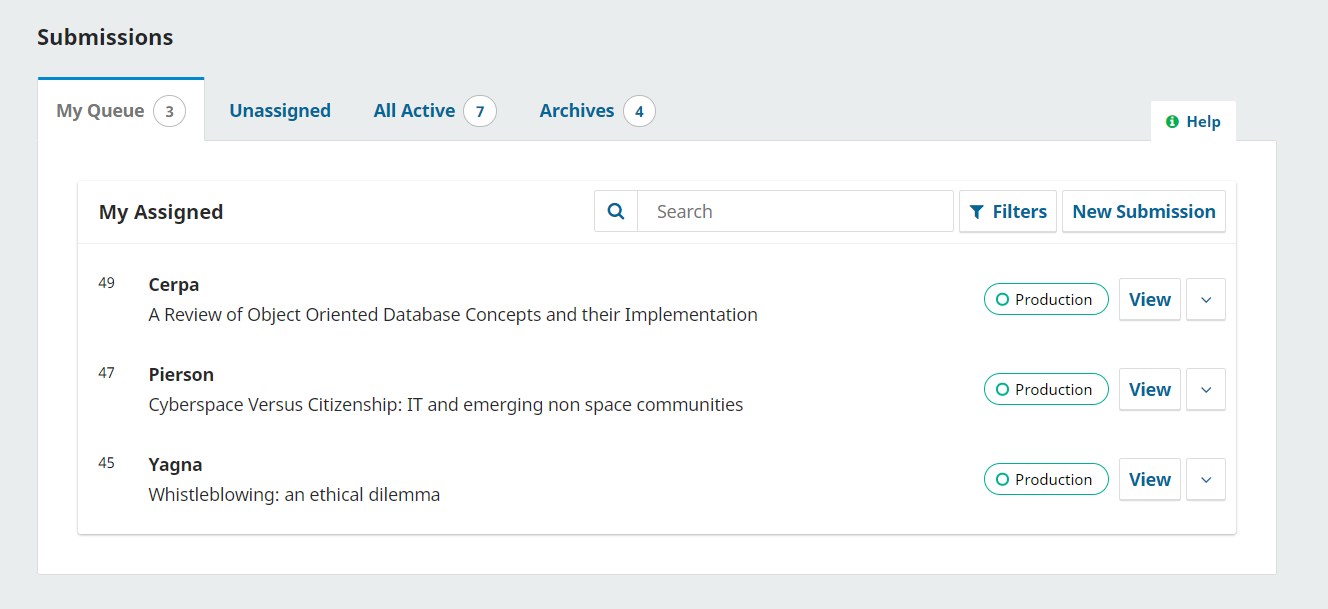
One time you find the submission, you can use the view button to view the submission, or employ the blueish arrow to reveal options and see if there are whatsoever open discussions (in that location are none in this case), the number of production galleys, and admission the activity log & notes.

Activity Log & Notes volition bring up the submission's history.
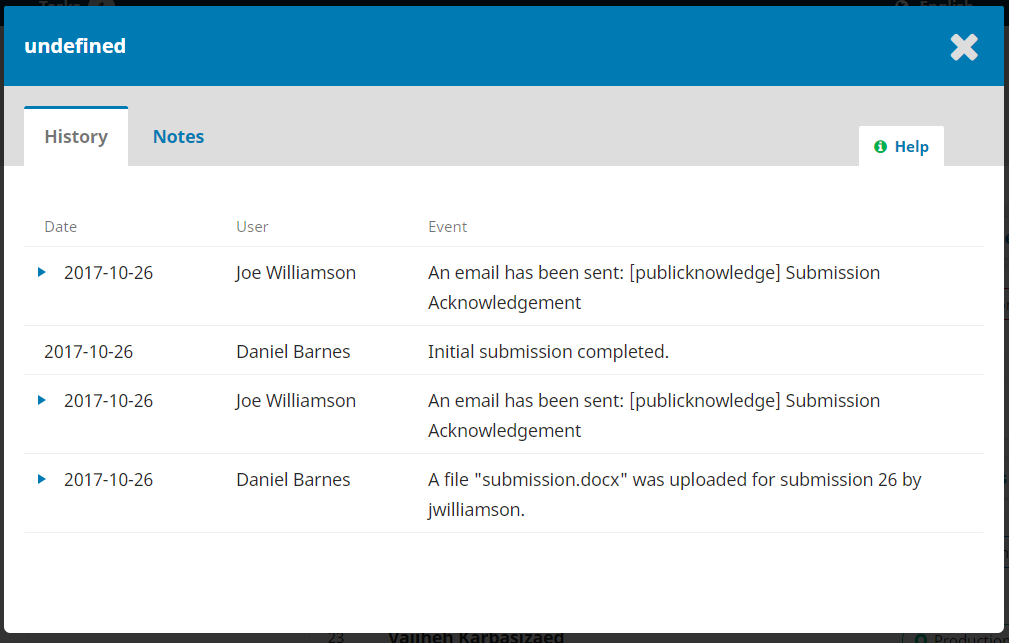
Use the Notes tab to besides view or add any editorial notes.

Submission Tape #
To view the submission in more item, select View Submission button. This will accept you to the submission record.
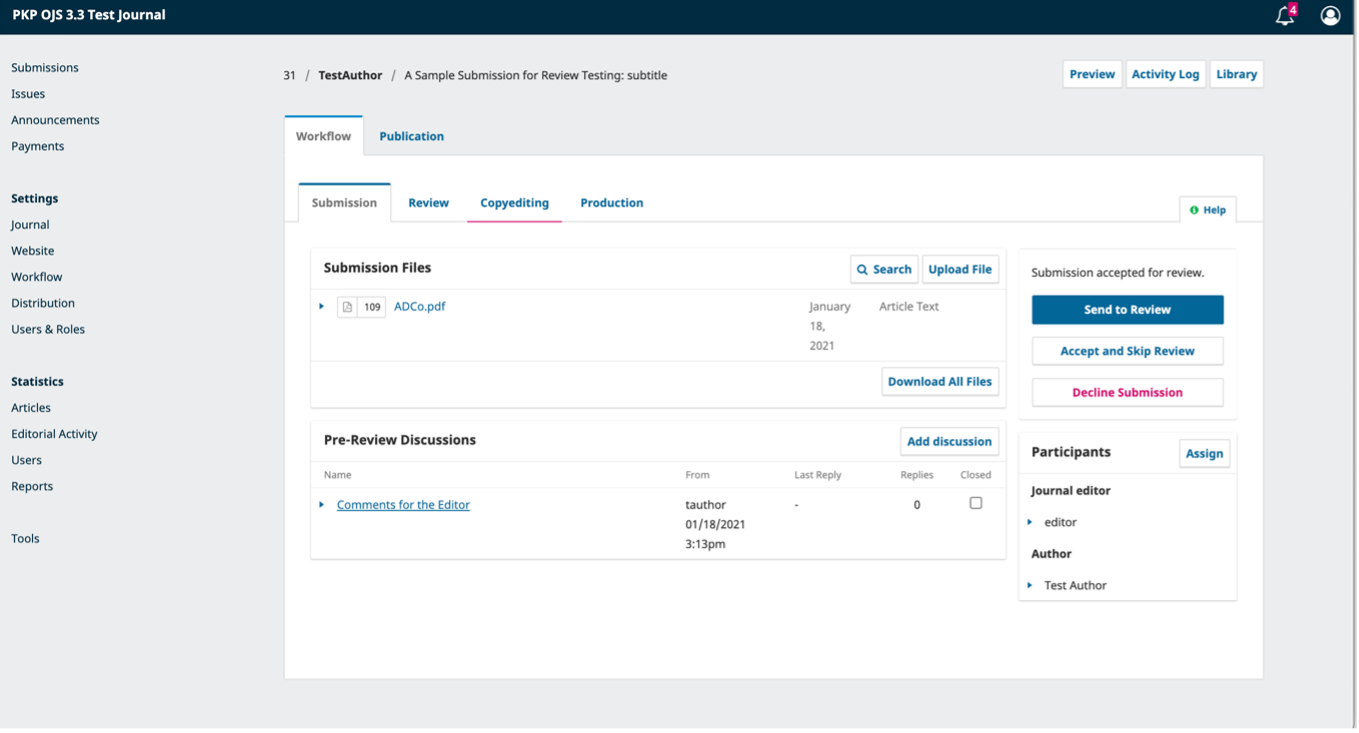
From hither, you can see:
Submission Files: This console lists the files that have been submitted. In this view, there is merely one file, but multiple files could have been submitted. Submission files will now retain the original names when downloaded.
For journals using anonymous review, the author and reviewer (if they were to upload whatever certificate) are still removed. An case filename construction for files downloaded by Reviewers will be ojs-review-consignment-1-commodity-text-8.docx The numeric number corresponds with the manuscript number of assignment.
Pre-Review Discussions: This panel allows the editor to communicate with the author, or with others on the editorial team. For example, to inquire the writer for some additional information, or to ask a section editor to take responsibility for this submission.
Activity Buttons: These include Send to Review, Accept and Skip Review, and Decline Submission.
Note: If you don't come across these buttons, yous probable take non yet assigned the submission to an editor.
Submission Status Once an editor has recorded a determination in one stage of the workflow of OJS three.2, the recorded decision will appear in place of the decision buttons. Editors will still have the ability to change the recorded conclusion past clicking, 'Modify Decision' this volition enable the 3 options in one case again.
 The screenshot above shows the decision push for MS# 425 prior to a decision beingness recorded. The screenshot below shows the notification of the recorded decision.
The screenshot above shows the decision push for MS# 425 prior to a decision beingness recorded. The screenshot below shows the notification of the recorded decision.
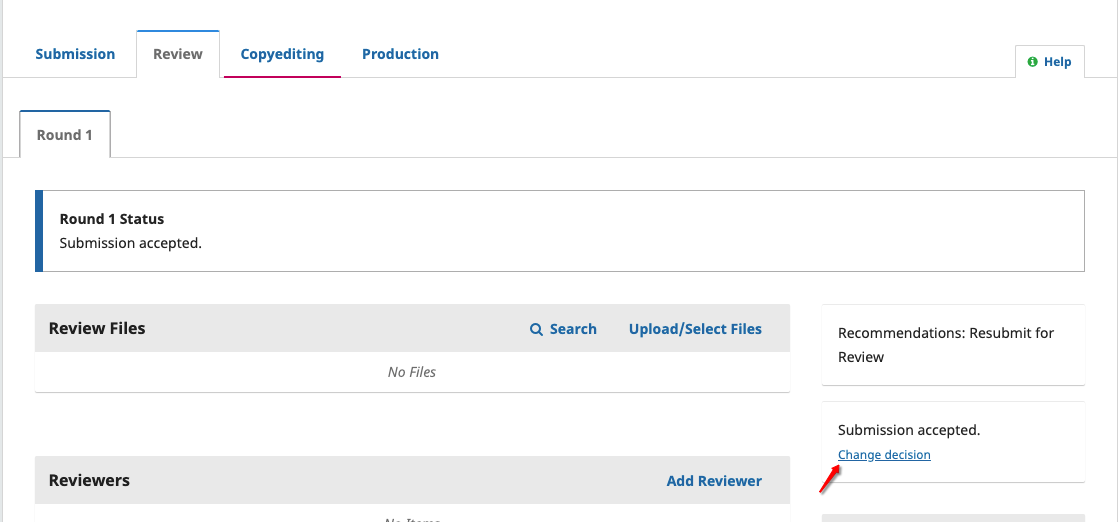
Participants: This panel is where y'all will run across the list of participants involved in the submission, including the editor, section editors, and writer. Other names (copyeditors, layout editors, etc.) will appear here equally they are added in subsequent steps.
Submission Library: The Submission Library is a general storage expanse for documents that may include conflict-of-interest forms, galley approving forms, etc. A user can upload the completed form for their manuscript in their Submission Library. The uploaded forms volition also exist available to other participants (with the exception of Reviewers) assigned throughout the editorial or production workflow to edit or re-upload new versions.
Document Library: Users throughout the editorial workflow volition be able to access all the files in the Publisher Library (run into Workflow Settings affiliate) made available past the Journal Manager or Editor through opening the Submission Library and clicking "View Document Library".
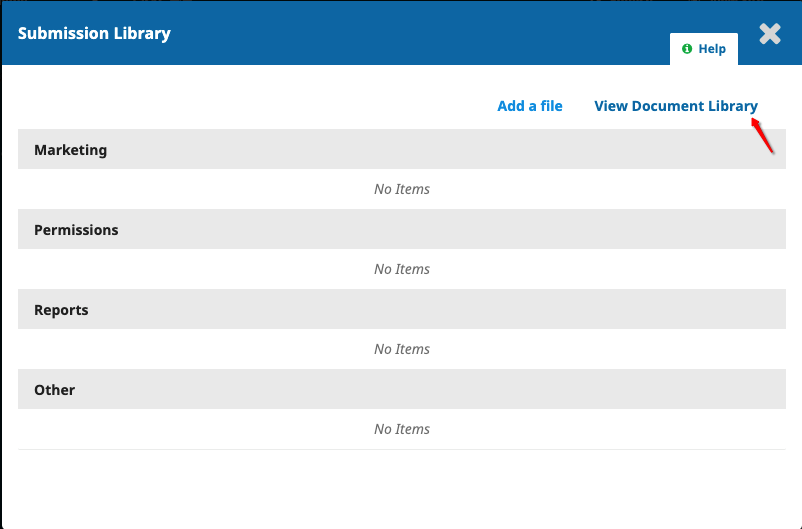
Preview: Run into how the submission will look when published with its current metadata and Galley files by clicking Preview.
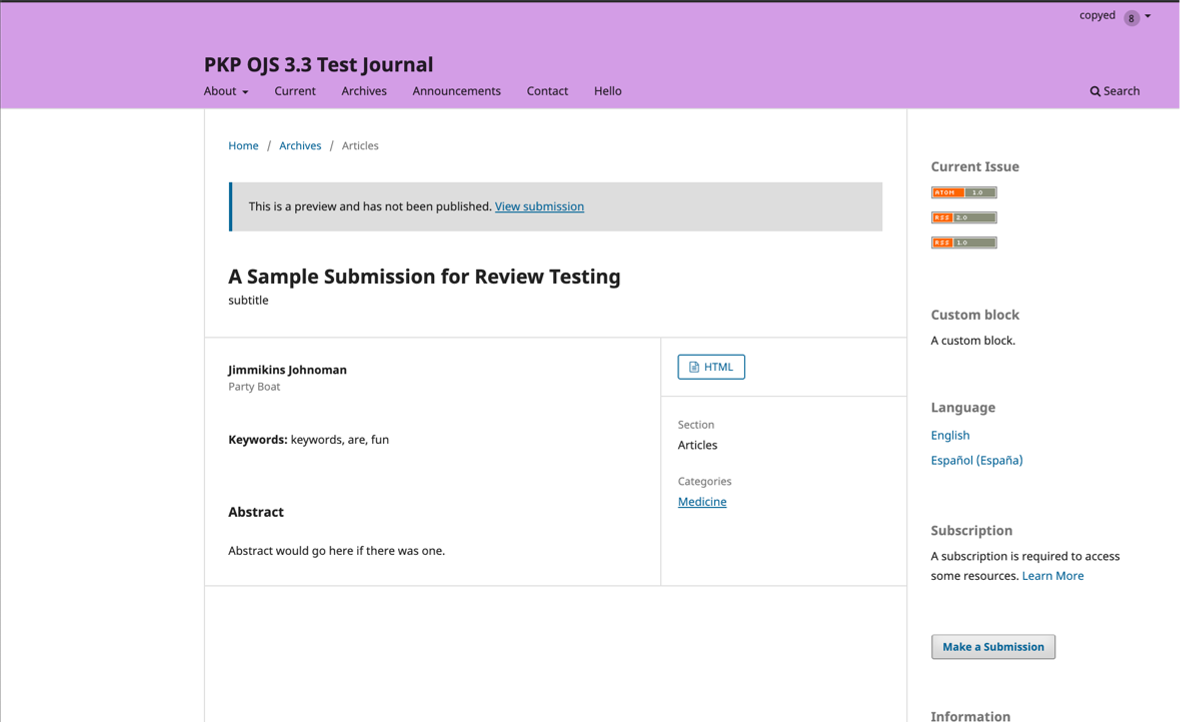
Metadata: Where yous can view and revise the submission metadata. In OJS iii.2 and subsequently, users can be granted permission to revise sure submission metadata at whatever stage of the workflow.

Equally of OJS three.2, editors can grant access to allow authors to brand metadata changes. There are two ways editors tin grant this type of admission.
Global permission- will grant all users with the part 'writer' permission to make metadata changes.
To enable this, become to Users & Roles > Roles. Click the bluish arrow abreast the 'Author' then click edit.

Under Office Options, enable 'Permit submission metadata edit.' then click OK.
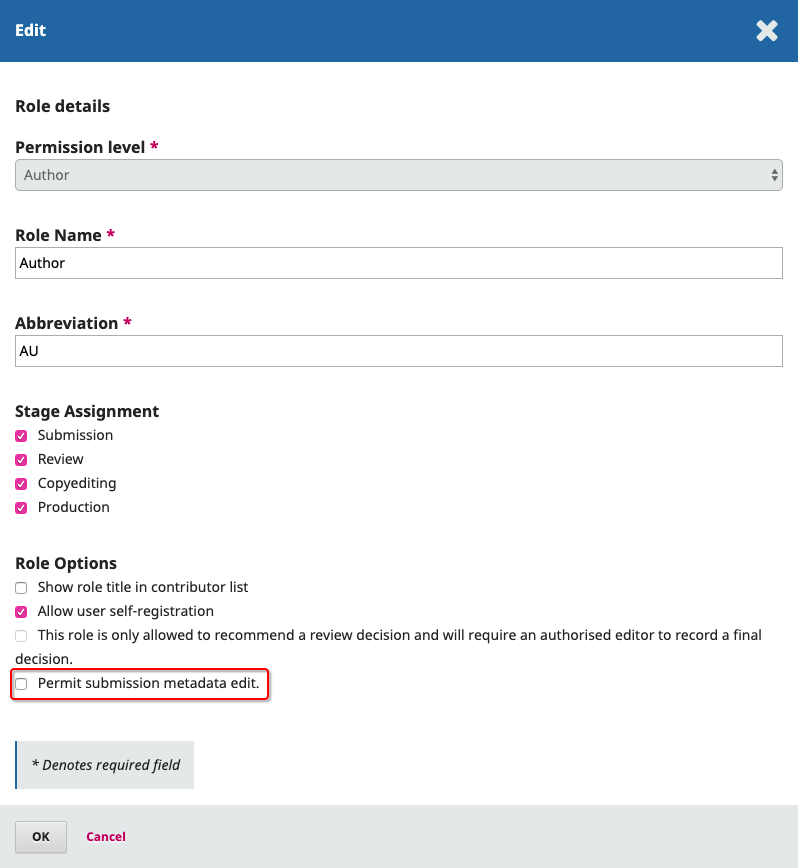
Express Permission - will grant registered authors (typically a unmarried author) permission to only make changes at sure stages of the editorial workflow.
To allow an author to alter the metadata at a specific stage of the workflow, click on the workflow stage (ie., Submission, Review, Copyediting, or Production).
Under the participants list, click the arrow abreast the author'south name followed past Edit.
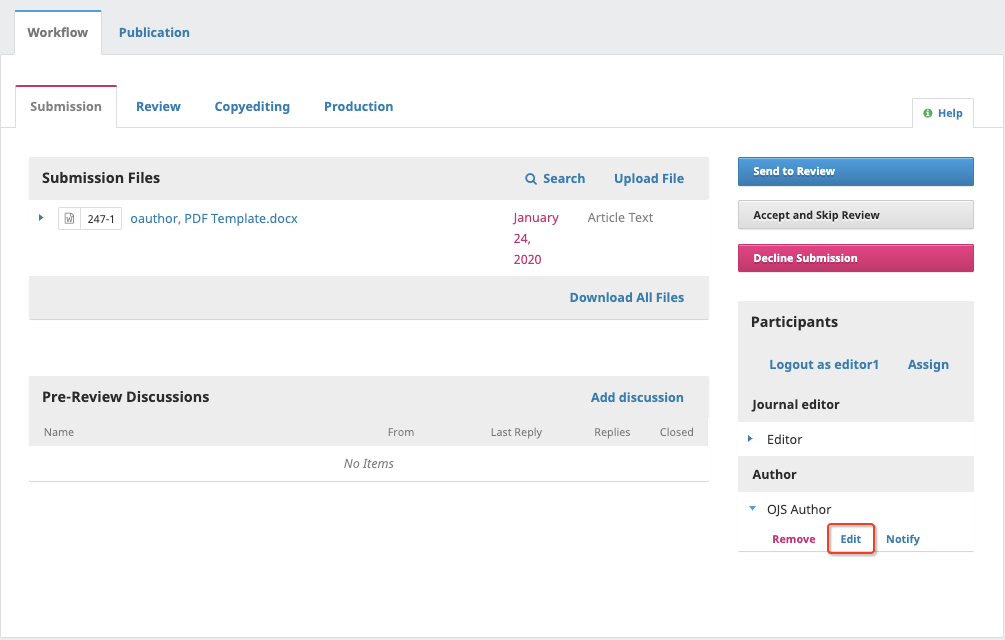
Nether Permissions, enable 'Permit this person to edit publication details.' followed by OK.
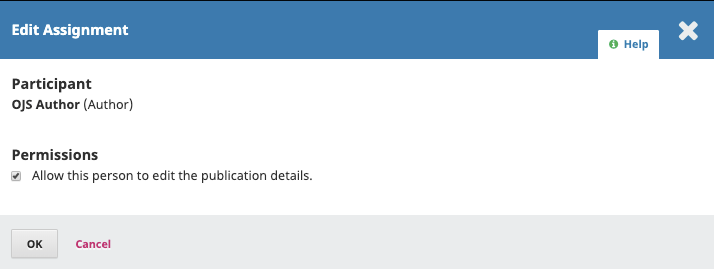
Once the writer has been granted access to made edits they will exist able to make changes to the following sections on the Publication tab: Title & Abstract, Contributors, and Metadata.
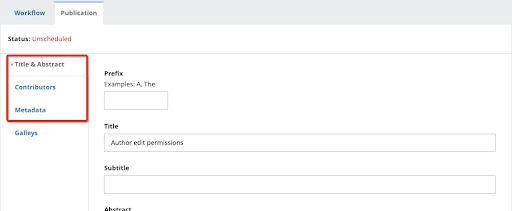
Assigning the Submission #
Depending on how you lot have your sections configured, some new submissions may come up in unassigned. If this is the instance, the next footstep is to assign an editor or section editor. To do so, select the Assign link in the Participants console.
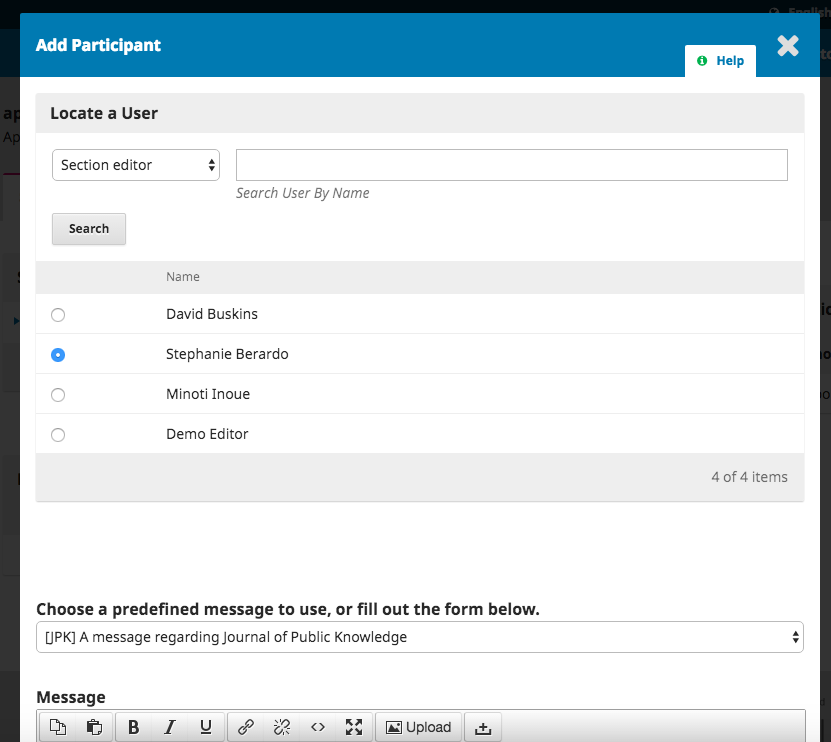
You will have the option to locate a user by role, choose an individual, and send them a message requesting their assistance.
Note: If yous aren't sure of the names of the section editors, simply choose that part from the dropdown menu and so hitting the Search button. All Section Editors will be displayed and available for choice.
Hit the OK push to brand the consignment and send the bulletin.

Notation the new Pre-Review Give-and-take that was automatically created as part of the assignment.
You can now see that the Section Editor is listed under Participants, and the Action buttons are bachelor:
Send to Review: Moves the submission on to the next stage.
Accept and Skip Review: Skips the Review Stage and moves the submission direct into Copyediting.
Reject Submission: Rejects the submission before going through the review process. The submission would then be archived. In OJS 3.iii, there is at present the choice to revert a Refuse decision in the Submission and Review phase. This can be done by clicking Alter Decision followed past Revert Decline. Subsequently a declined decision is reverted, the submission is restored to its previous stage and review round if active.
Although in this instance, the editor assigned a section editor, it would too be possible for the editor to assign themselves to the submission.
Once the editor has selected an action, the submission condition will change and the action buttons volition be disabled.

Section Editor #
At present that the Department Editor has been assigned, they can login and view their dashboard. The submission can be plant at the top of the My Assigned queue.
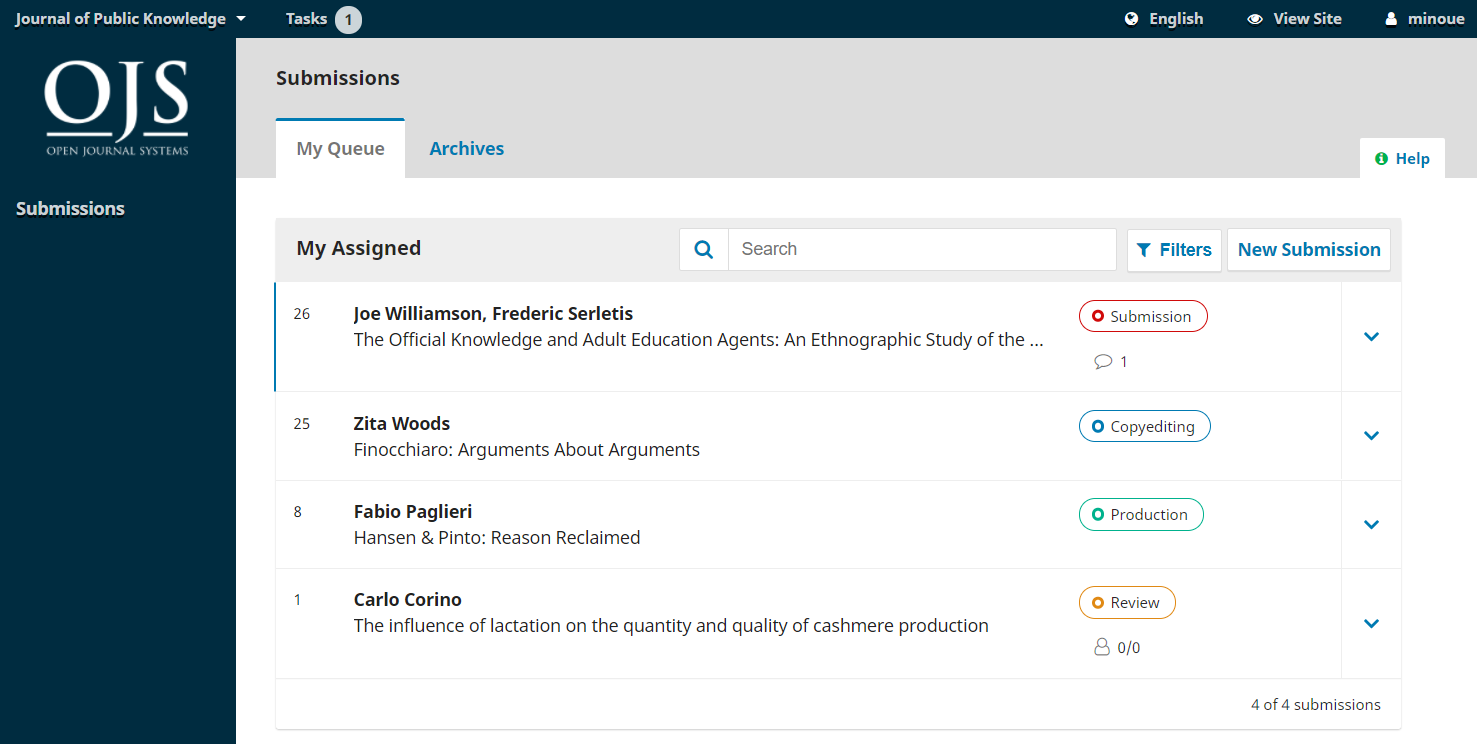
Clicking on the commodity title opens the full submission tape.
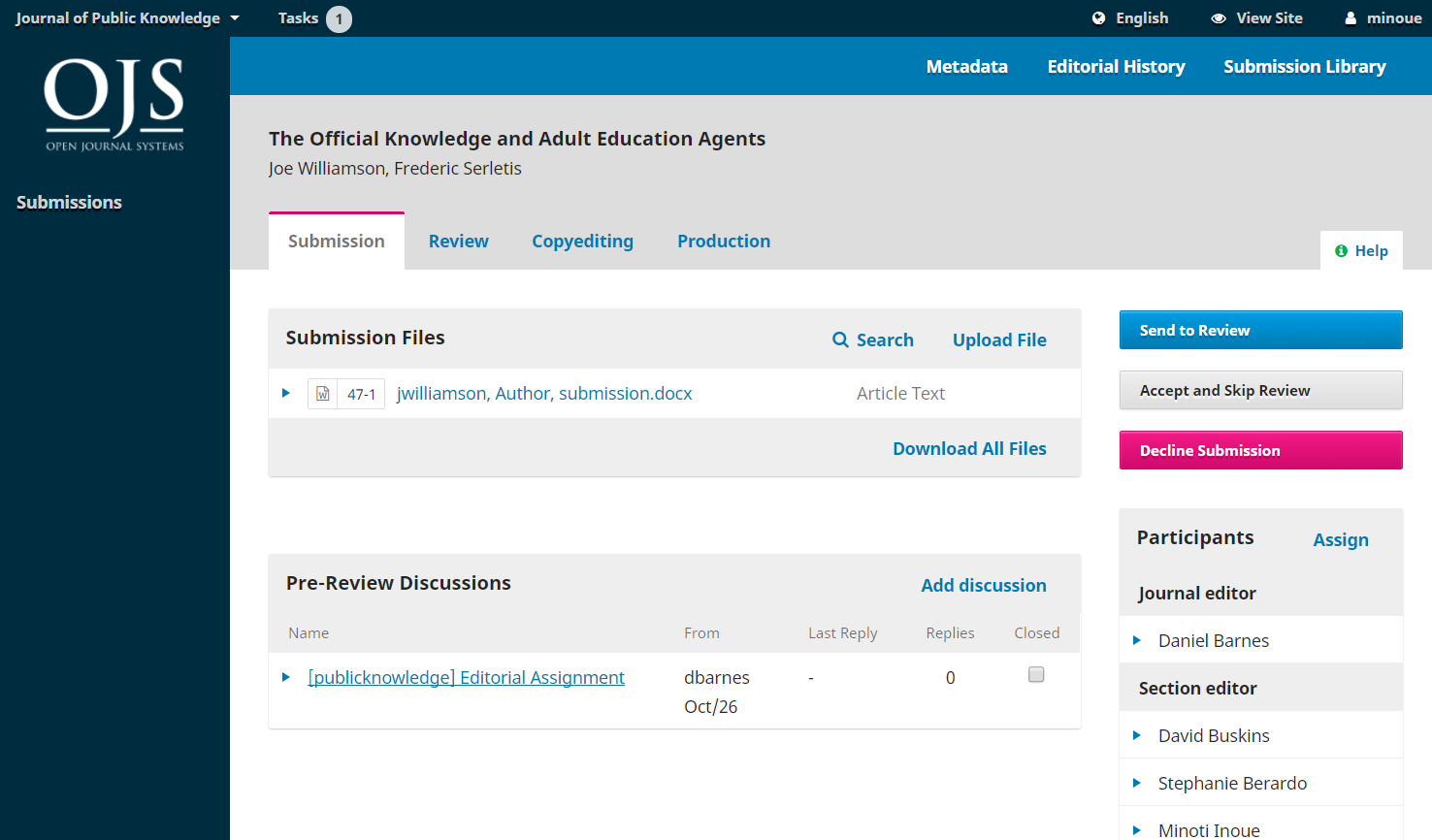
Accepting the Assignment #
It is not required, but the Department Editor could respond to the Pre-Review Give-and-take to inform the editor that they volition exist proceeding with the assignment.
Communicating with the Author #
If the Department Editor has whatsoever questions for the author, they can utilize the Pre-Review Discussions.
Sending to Review #
Once the Section Editor is satisfied that the submission is appropriate for the periodical, they can select the Send to Review push to move the submission to the next stage.

Go along the files that are to be reviewed checked off.
Review #
This PKP School video explains the steps the Department Editor takes to assign reviewers to the submission. To watch other videos in this series, visit PKP's YouTube channel.
When the submission enters the Review Phase, a notification indicates that Reviewers need to be assigned.
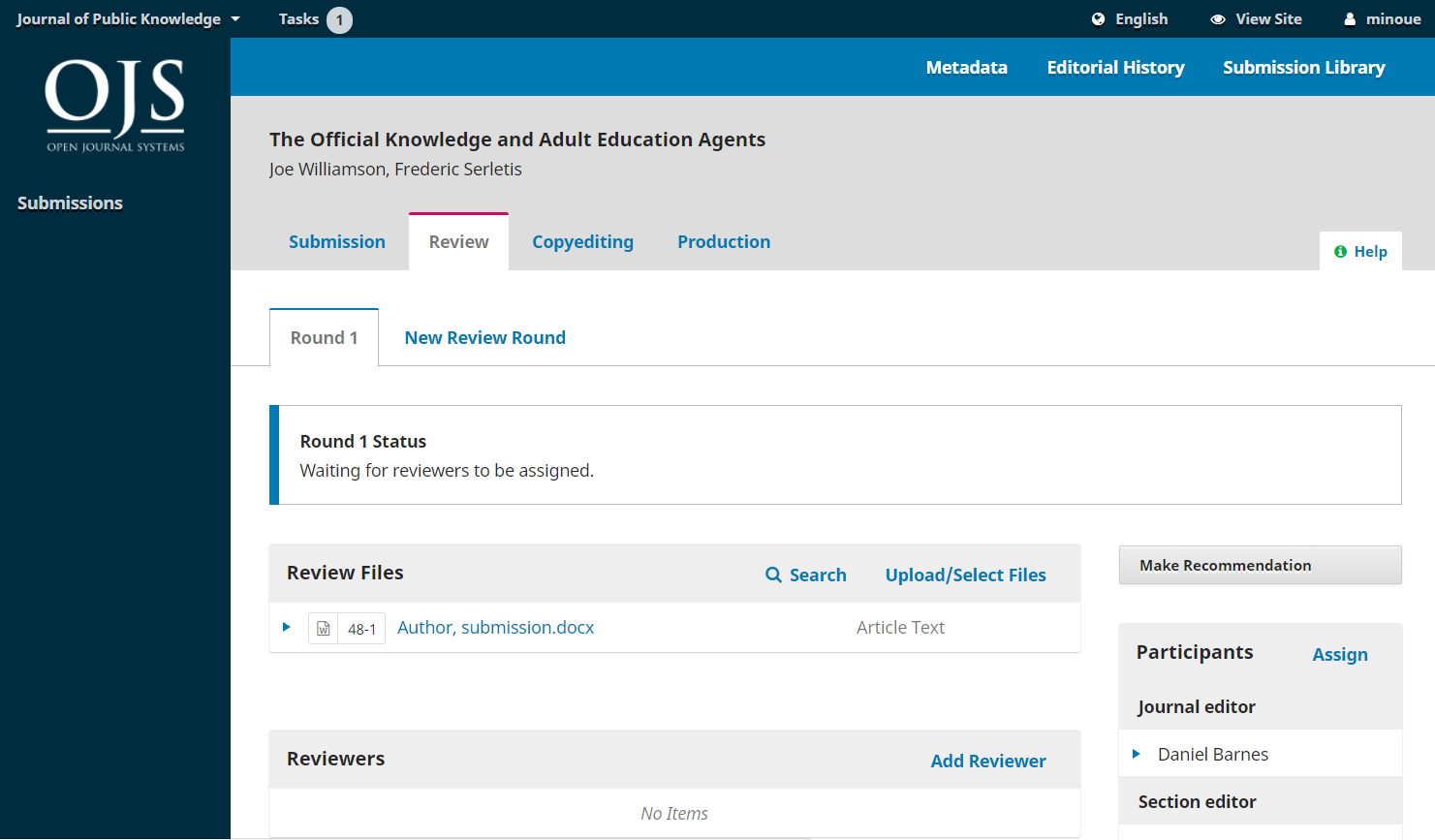
Note: In the screenshot above, we see the Section Editor'due south view. Notice the limited Action buttons (only Make Recommendation is bachelor). If nosotros were logged in as an Editor, we would see more Activity buttons (Asking Revision, Take Submission, Decline Submission).
From the Reviewers panel, you tin can select Add Reviewer to assign a new Reviewer.
This opens a new window, where Reviewers are listed and can be selected one at a time.
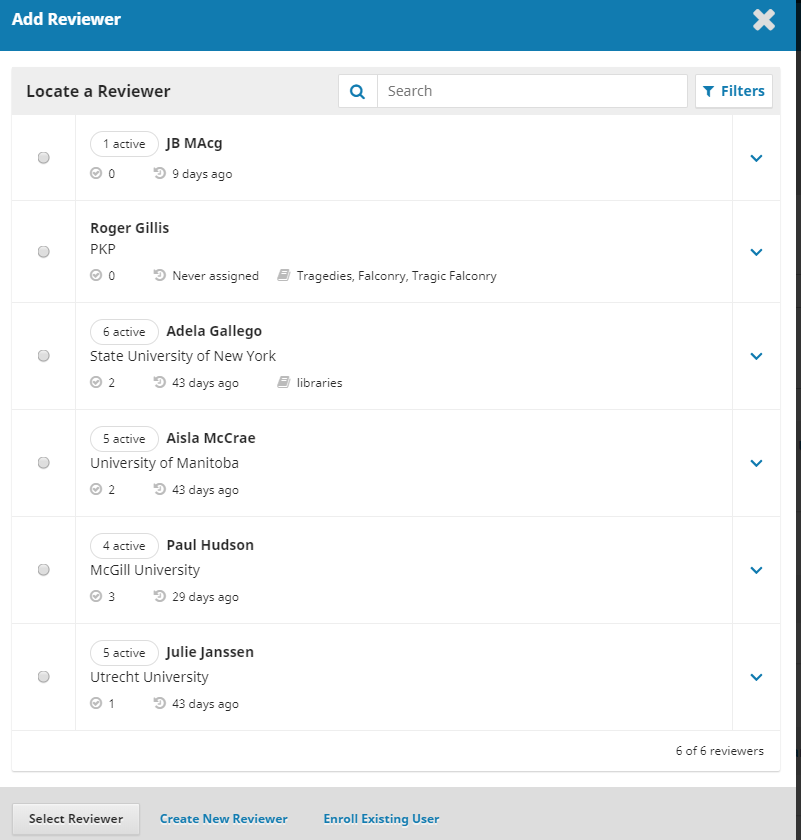
Clicking on the blue arrow reveals more information about their review history, including how many active reviews they are currently assigned, how many reviews they have completed or declined, etc. If the user has added a Biography or Reviewing Interests, this data will exist displayed here.
Additionally, a Periodical Editor can add an Editorial Annotation about the reviewer in their profile under Users & Roles > Users. This note will appear in the reviewer details on the Add together Reviewer screen, simply will not be visible to the reviewer or to the public.

In OJS releases 3.0 to iii.i.0, you lot cannot assign a user to review a submission if they are also an editor of the submission. If you exercise, the editor will no longer be able to access the submission after they submit their review, in order to maintain the principles of anonymous peer review. However, starting with OJS 3.1.i, yous tin can assign a user to review a submission if they are as well an editor of the submission.
At the bottom of this grade, you will run across options to:
Select Reviewer: Employ this to ostend your choice in one case you lot have picked a Reviewer from the list.
Create New Reviewer: If none of the Reviewers are suitable, you can use this button to create a new Reviewer. This is a new account in the arrangement.
Enroll Existing User: If none of the Reviewers are suitable, you can enroll an existing user as a Reviewer.
For this demonstration, we will option Adela as our Reviewer and hit the Select Reviewer push button.
This initiates a new window with a message for the Reviewer.
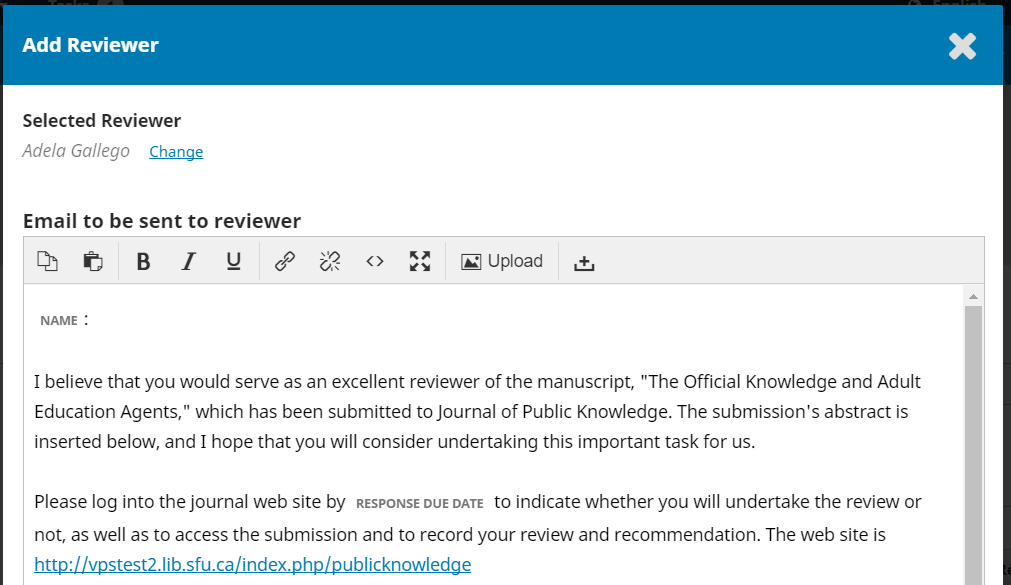
You can revise whatever of the prepared text.
If yous are using an Anonymous Review method, ensure that the files y'all transport to the Reviewer are stripped of any identifying information about the Author. Boosted instruction for this is provided in the Understanding Bearding Review and Removing Identifying Information sections.
Further down the form, yous will see the boosted details that are sent to the Reviewer including title, abstract, important dates, and a link to the files to be reviewed.
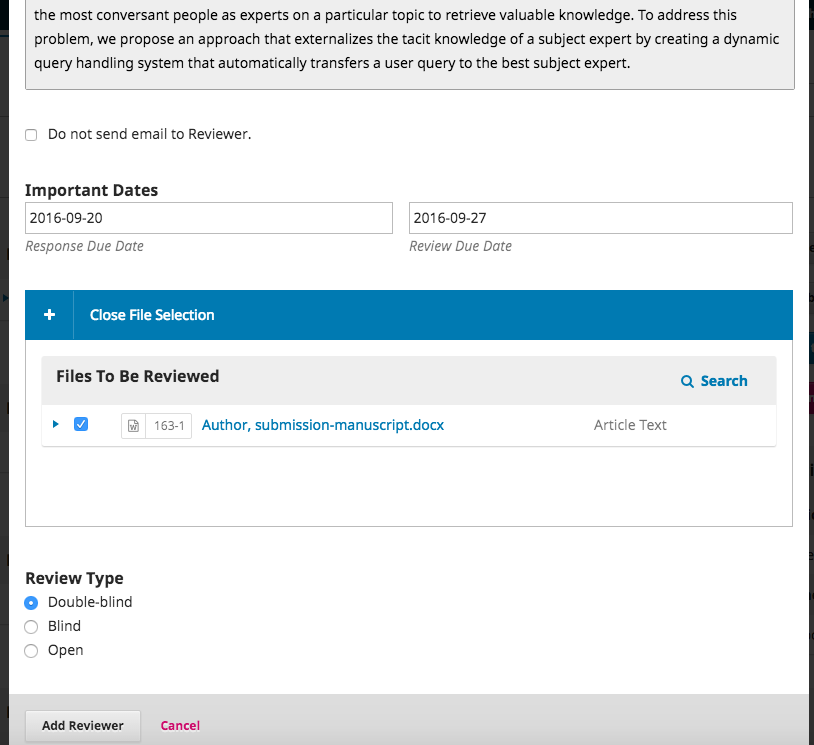
By default, Reviewers will be provided with an extended text box to blazon in their comments. However, the Journal Manager can create Review Forms in Workflow Settings > Review to ask more focused questions. If you lot would similar the Reviewer to fill out a review grade, select information technology nether Review Grade.
Hit the Add Reviewer push button to send the message and assign the Reviewer.
Back on the Review Stage, we can see the Reviewer is at present listed.

Yous can make additional changes using the blueish arrow toggle adjacent to the Reviewer's name.

Review Details: Provides details on the review.
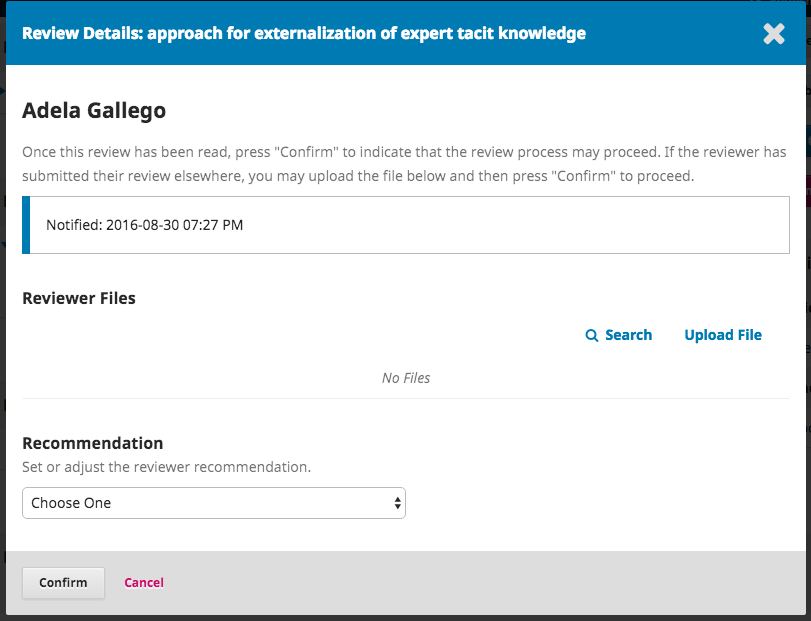
Email Reviewer: Allows you to send a message to the Reviewer.

Edit Review: Allows yous to change the review dates and files.
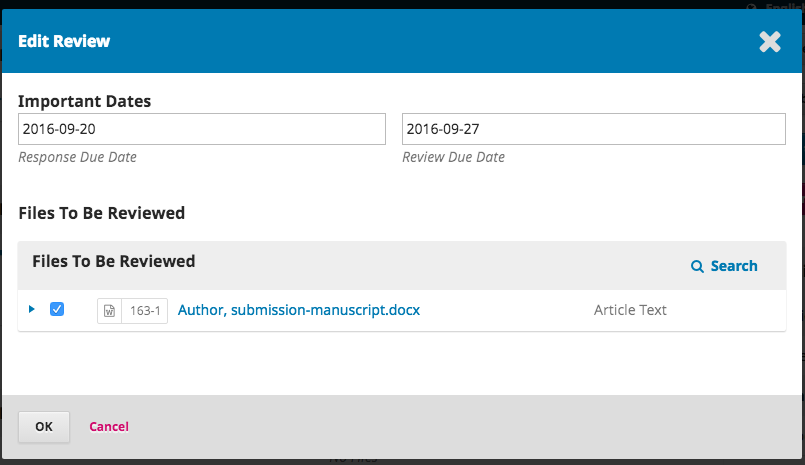
Unassign Reviewer: Allows you to unassign the Reviewer.
Abolish Review Request: As of OJS 3.2, y'all tin cancel a review request. This may be necessary when a reviewer has non responded to a review request or accustomed to do a review but never delivered.
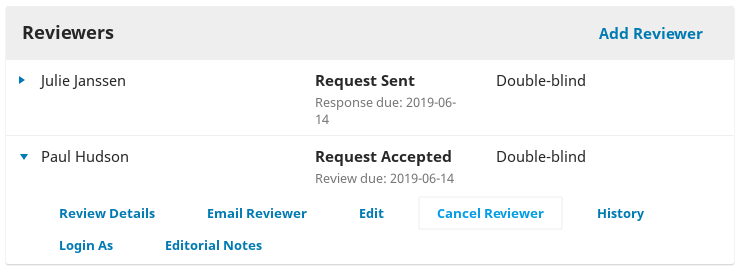
Cancelling a review request volition allow you to transport a template email to the reviewer. The request will and then show up in the editor's reviewer list as "cancelled".

Cancelled review volition be recorded in reviewer stats that you can encounter when selecting a reviewer.
![]()
Review Discussion: Review Discussion is another manner for you lot to contact a reviewer. In a review discussion, y'all have the selection to attach files.
To get-go a discussion, click 'Add Discussion.'

You will then select the reviewer(southward) you would like to start a discussion with.
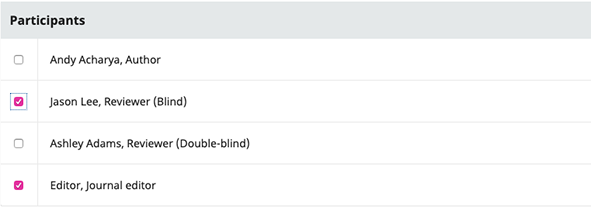
History: Provides a brief history of the review.

At this point, we could add additional Reviewers, and and then wait for their recommendations to come in.
Agreement Anonymous Review #
OJS is designed to accommodate different types of reviews and has built-in steps to ensure anonymity.
All information will exist visible to the journal managers and editors regardless of the type of review selected. The review type will be automatically selected based on what has been configured under Settings > Workflow > Review. The editors can change the review type when sending the review request. Editors/Section Editors must select the review type when sending the review request from the following options:
- Anonymous Reviewer/Anonymous Author
- Anonymous Reviewer/Disclosed Author
- Open
Anonymous Reviewer/Anonymous Writer: The identity of both the writer and the reviewer is kept hidden.
The author or editor must ensure that metadata from the manuscript file is removed in Bearding Reviewer/Anonymous Author. See Removing Identifying Information for more information.
Reviewer: The reviewer will non be able to see the author(due south) in their reviewer's queue if the editor has selected Anonymous Reviewer/Bearding Author. All identifying information in the metadata of the submission details is automatically removed by the system, equally seen in the example below.
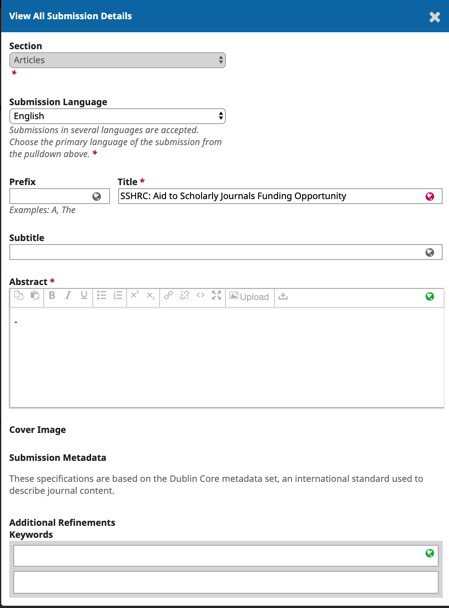
At the finish of a review, if a reviewer chooses to upload a review file they should remove all identifying information before uploading it to the organization. See Removing Identifying Data for more information.
Author: No identifying information regarding the reviewer will be visible to the author within their manuscript view.
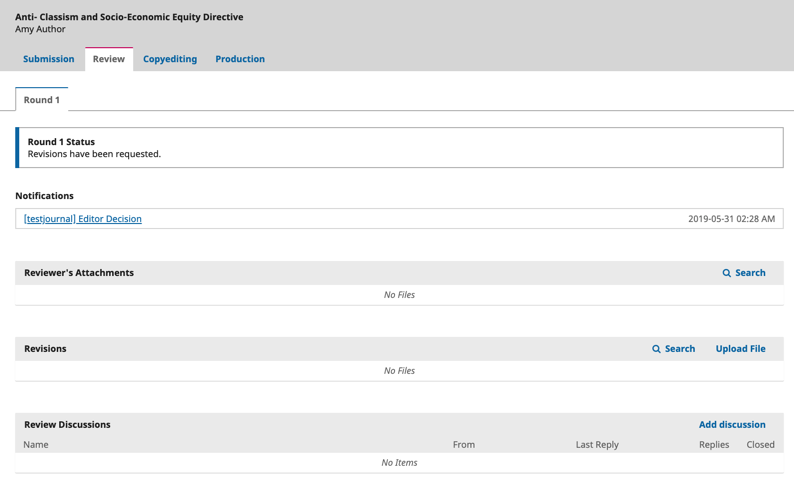
Editor'southward Decision: The determination e-mail sent to the author(due south) at the terminate of a review will have generic titles of the reviewers.
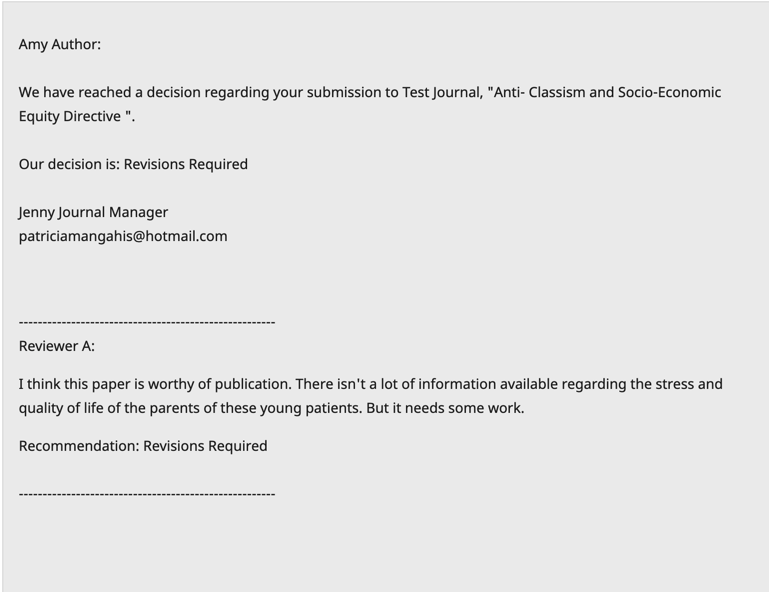
Anonymous Reviewer/Disclosed Author: Reviewer identity is kept bearding from the writer(s). The reviewers can come across the author details.
Reviewer: The reviewer is able will see full the metadata entered by the author by clicking View All Submission Details in the asking tab of the manuscript. The authors' name will also appear in the reviewer's queue.
Author: No identifying information regarding the reviewer will be available within their manuscript view.

Editors Determination: The conclusion email sent to the author(s) at the end of a review will accept generic titles of the reviewers.

Removing Identifying Information #
While OJS has a number of built-in functions for anonymous reviews, boosted steps may need to be taken outside of the platform to ensure Anonymous Reviewer/Anonymous Author. A submission file may have information that could identify the authors' identity inside the certificate properties.
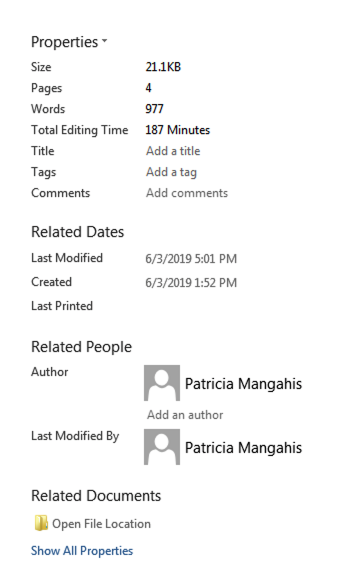
Authors may also include their name within the article, footnotes, or references, in which case the editor volition have to remove it prior to sending for review. Alternatively, authors tin can be asked to redact their names from the submission file, with "Author" and yr used in the references and footnotes instead of the authors' name, article title, etc., prior to submission.
Microsoft Word for Windows #
- Become to File
- Select Info
- Click on Check for Issues
- Click on Inspect Document
- In the Certificate Inspector dialog box, select the cheque boxes to cull the types of hidden content that y'all want to exist inspected
- Click Remove All
- Click Close
- Salvage the document
Microsoft Discussion for MacOS #
- Get to Tools
- Click Protect Document
- Select Remove personal information from this file on save
- Click OK and relieve the file
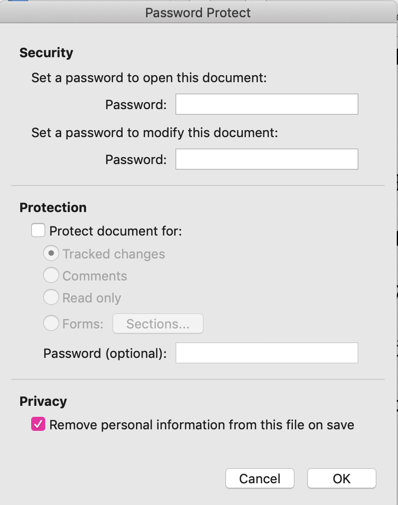
Re-uploading the Document #
The Periodical Managers and Editors are able to re-upload the anonymized certificate in the Review files by clicking Upload/Select Files in the Review Files box.

Click Upload Review File.
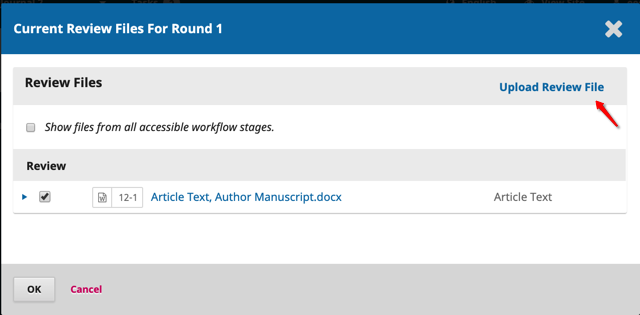
Place the article component and upload the file.

Review Details. Information technology may be helpful to rename the file to the fourth dimension of re-upload. The file tin can also be renamed past clicking the arrow on the left side of the file name.

Click Complete and select the file you would like to use for the review.
The file(s) volition appear under the initial upload. When sending out the review asking, ensure that the original manuscript is unselected from the 'Files To Be Reviewed'.

Select the Review File(southward) and click OK.
Responding to Reviews #
This PKP Schoolhouse video explains the steps the Section Editor and the author take one time the reviews are consummate. To sentry other videos in this series, visit PKP'southward YouTube aqueduct.
In one case the Reviewers have completed their work, the Section Editor can run into the results in their dashboard. Here they will see notifications that new reviews take been submitted and whether all reviews are in.
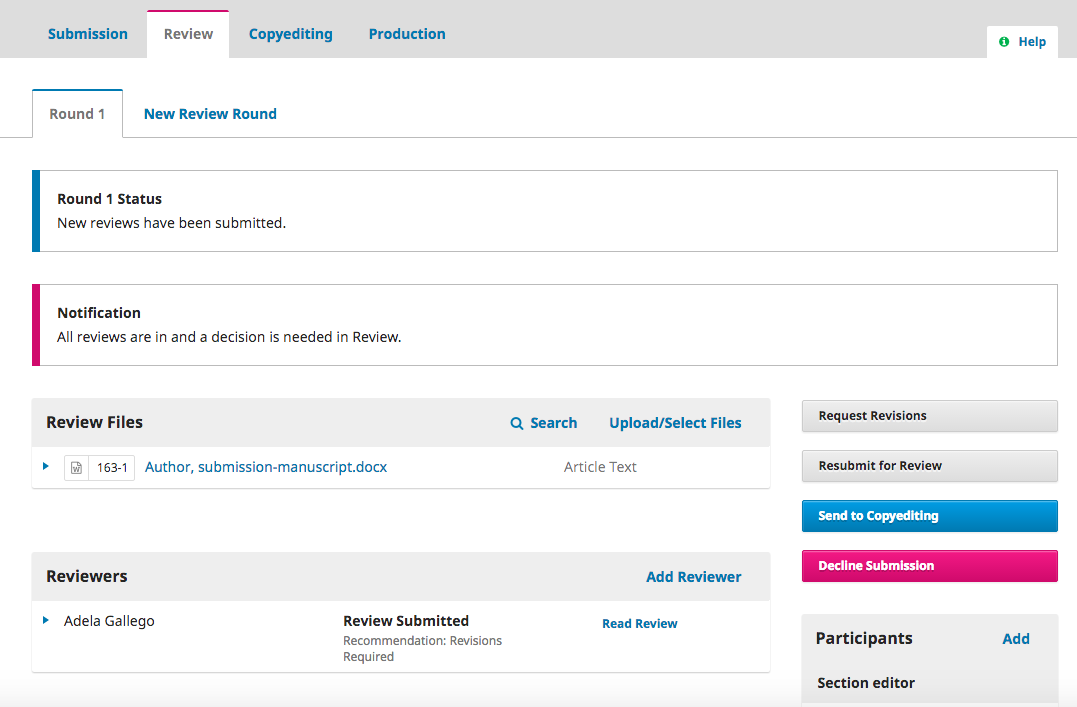
Use the Read Review link in the Reviewers console to read the comments from the Reviewers, including those for both the Author and Editor also as for the Editor only.

Select the Confirm link at the bottom of the screen.

In the Reviewers panel, you tin can now see a Thank Reviewer link. Choose that to thank the Reviewer.

Striking the Thank Reviewer push to send the message.
Making the Decision #
Based on the Reviewer recommendations, yous tin can use the action buttons to make a decision.
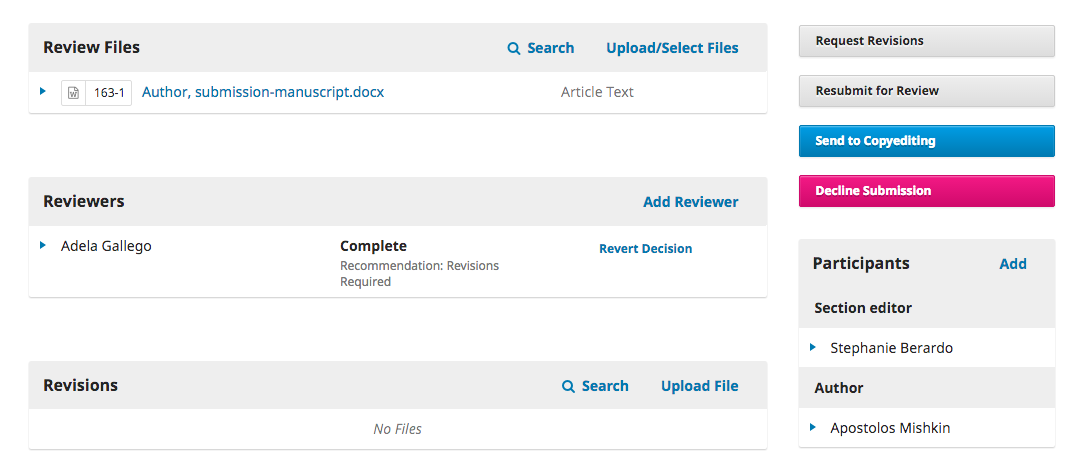
Options include:
Asking Revisions: This will require the Author to make small-scale changes, the editor has the option to select whether some other round of review will be required.
Take Submission: This means the submission is accepted without revisions and can proceed to the Copyediting stage.
Decline Submission: This means that the submission has not passed peer review and is unsuitable for farther consideration. The submission would then motility to the Archives. But declined submissions in the Archives can be deleted. In OJS 3.3, there is now the option to revert a Refuse decision in the Submission and Review stage. This tin can be washed past clicking Change Decision followed by Revert Pass up. After a declined decision is reverted, the submission is restored to its previous stage and review circular if agile.
Request Revisions #
In this demonstration, we are going to request that the Author brand some small revisions before acceptance.
To do and then, select the Request Revisions button. This results in a new message window.
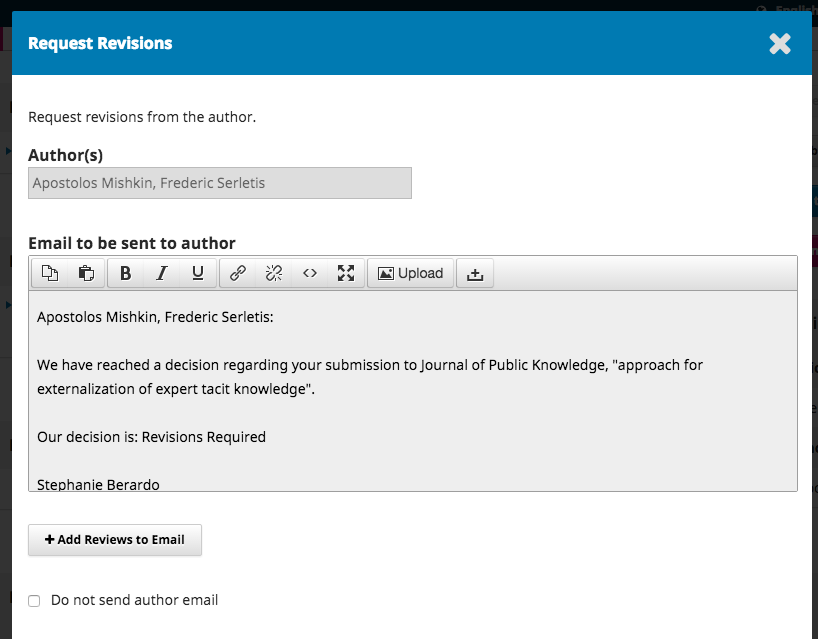
You can modify any of the text earlier sending the message.
Apply the Add Reviews button to import the Reviewer'due south comments from the Editor and Writer field. Comments in the Editor only field will not be displayed.
If there are whatsoever attachments, such as a marked up file created past a Reviewer, you can attach information technology here (equally long every bit it has been anonymized). In OJS iii.1.ii and later, you can besides upload a new file and add information technology as an attachment.
Hit the Record Editorial Decision button to send the message.
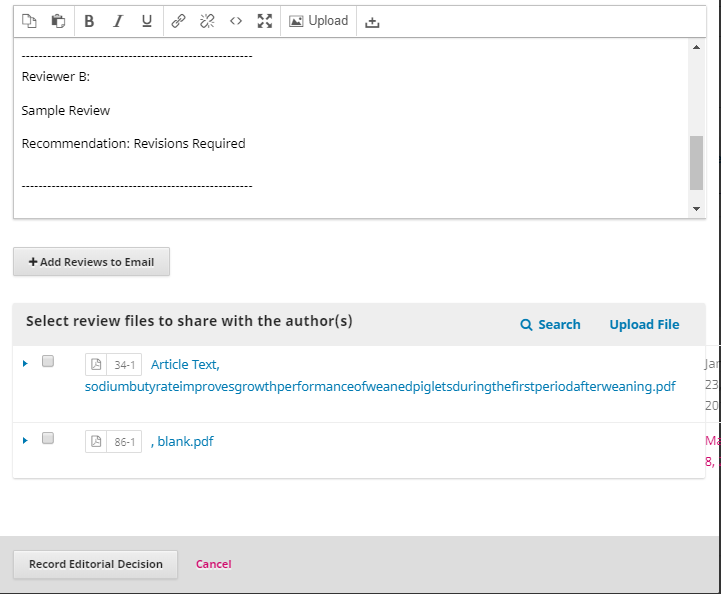
You must at present look for the Author to respond with their revisions.
Author Responds #
Once the Author has fabricated the revisions, you lot should receive a message (via e-mail and the Review Discussions panel).
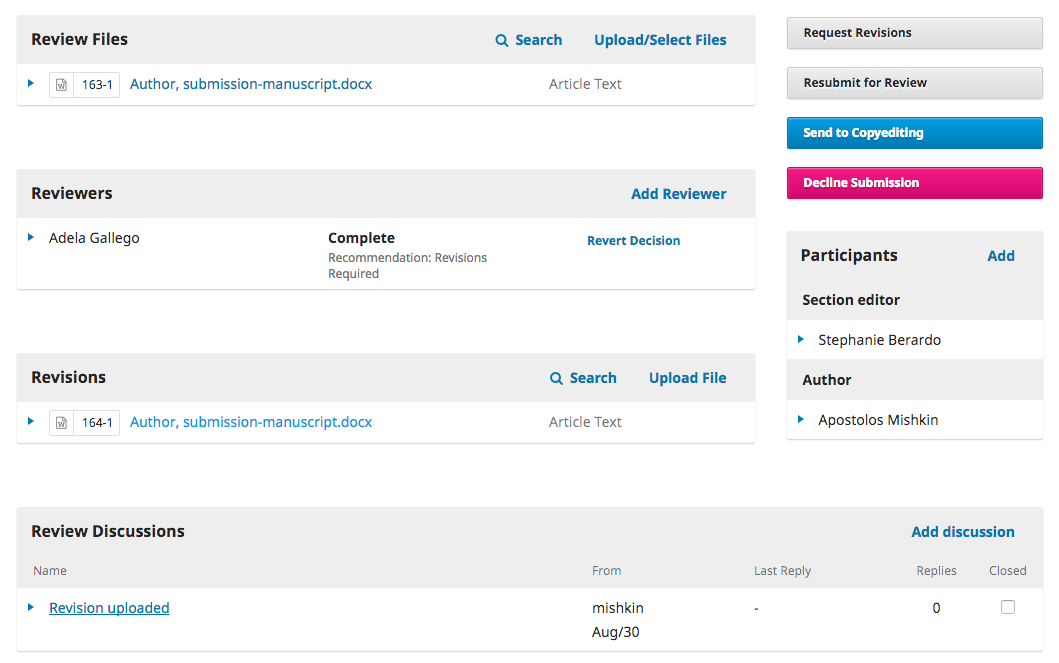
You will besides see the revised file in the Revisions panel.
At this betoken, you tin can download the revised file, check to make sure it is ready, and communicate with the Author using the Review Discussions panel.
In this case, nosotros're going to inform the Author that we are accepting the revisions. To practise and then, click on the linked championship of the discussion. This will open up the discussion box.
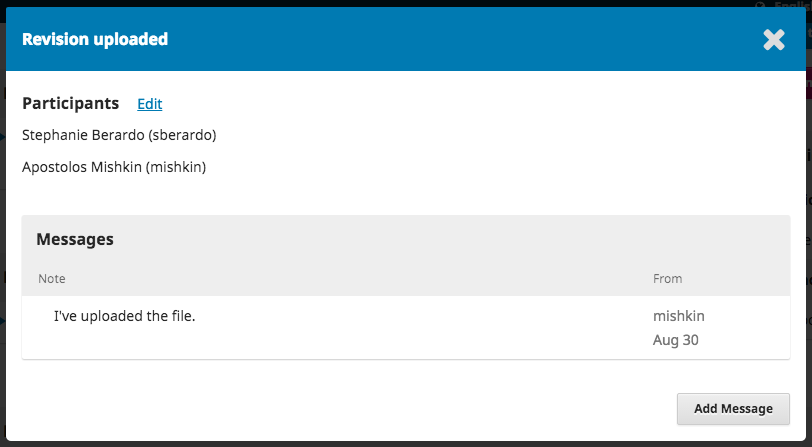
Use the Add Message push to reply, either requesting farther revision or informing the author that the submission is ready to movement on to the adjacent phase.
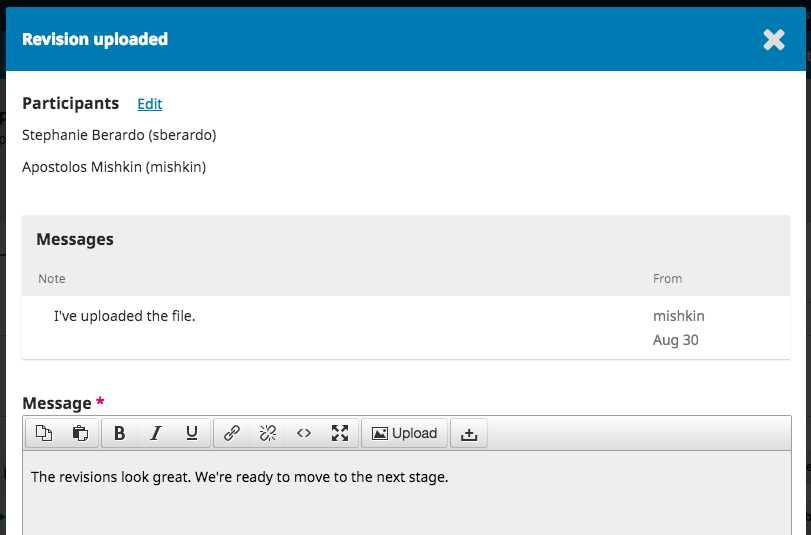
Additional Round of Review #
If you would similar to put the revised article through another round of review, yous can get-go a second (or third or subsequent) review round later on the author revisions have been received.
Information technology is best to showtime a new circular of review after an author uploads revised files on the previous round. Creating a New Round of review earlier the author has uploaded their files could create some confusion as their dashboard (and yours) will default to the new circular. The author will, nonetheless, exist able to switch back to Round one to upload their files. This will also effect in having to download the uploaded file from Round i and upload information technology into Circular 2.
A new round should non be started if you are experiencing whatsoever problems with the current circular (i.e., unable to tape determination, re-invite a declined or removed reviewer).
To start an additional round of review later revised files have been received, click the New Review Round tab in the review tab of the manuscript.
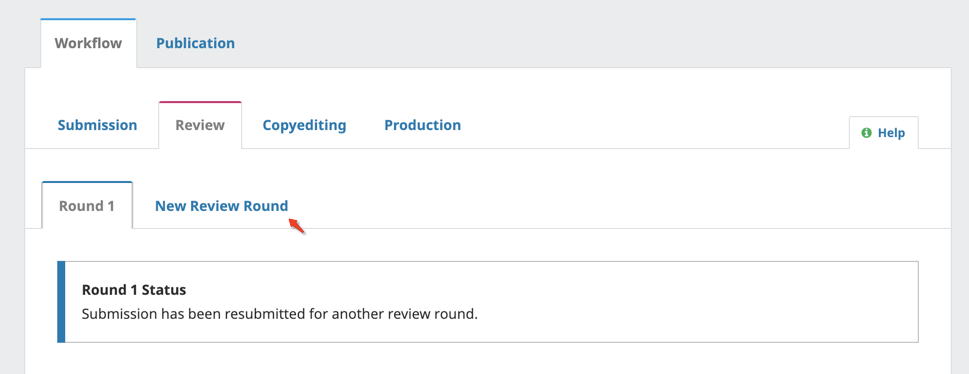
This will open up another carte du jour for you to select which files (provided past the author) to include for the new round of review.
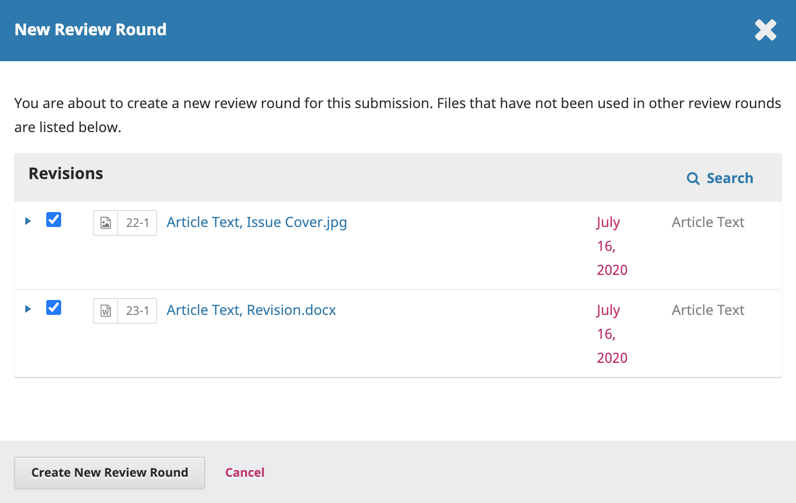
If at that place are whatsoever additional files you want to brand bachelor again from the previous round, this tin be done by clicking Upload/Select Files.

Check the box next to Show files from all accessible workflow stages. The files available from Round 1 should appear under Submission. The files that appear under Review volition just bear witness files uploaded by the author from the previous round (i.e., revised files from Round i). If yous are on Round iii (and onwards) and require files from Circular ane or ii, you will demand to download these to your local desktop and re-upload them using Upload/Select Files.
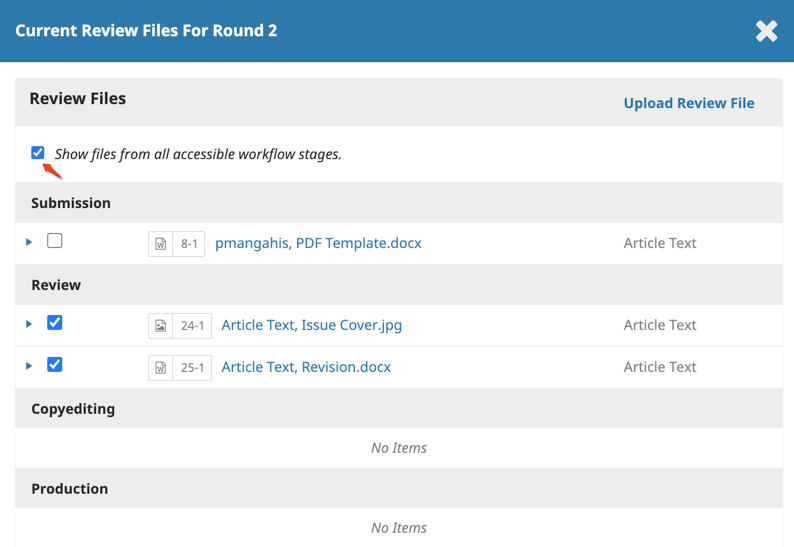
Similarly, if there are any additional files authors provide after they upload the resubmission, you can upload them using Upload/Select Files.
A new round volition be added to the Review panel in the submission dashboard.
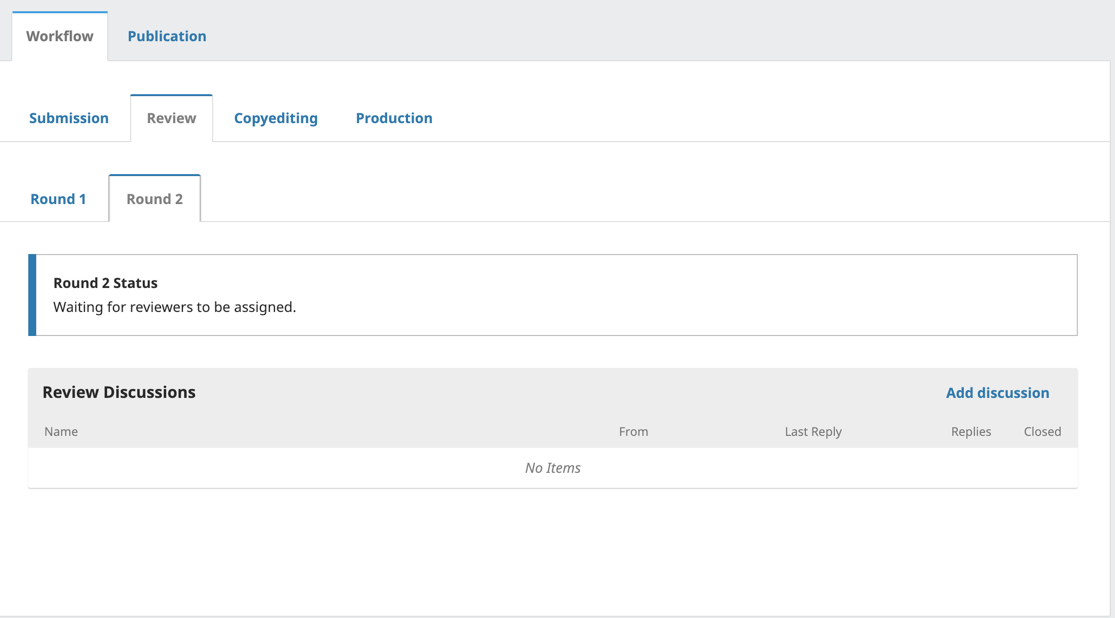
In one case you're fix to kickoff the new round of review, assign Reviewers as you did in the previous round. You lot tin assign the same reviewers or dissimilar reviewers.
Reviewers from previous rounds will non have access to comments they've made the round before. If a reviewer has requested their comments from the previous round, the editor could copy this from Round one - Review Details and kickoff a discussion in Round 2. Alternatively, the journal may cull to encourage the submission of Response to Reviewer equally part of the resubmission.
These steps can be repeated until a final determination to take or decline the manuscript has been reached.
Moving to Copyediting #
The submission is now ready to be moved to copyediting. To exercise so, use the blue Send to Copyediting push button.
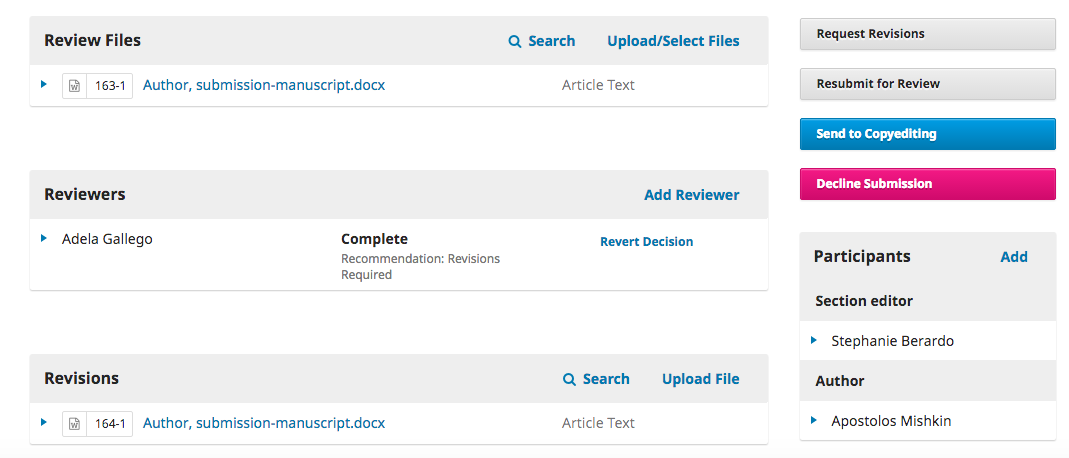
This will open a new window.
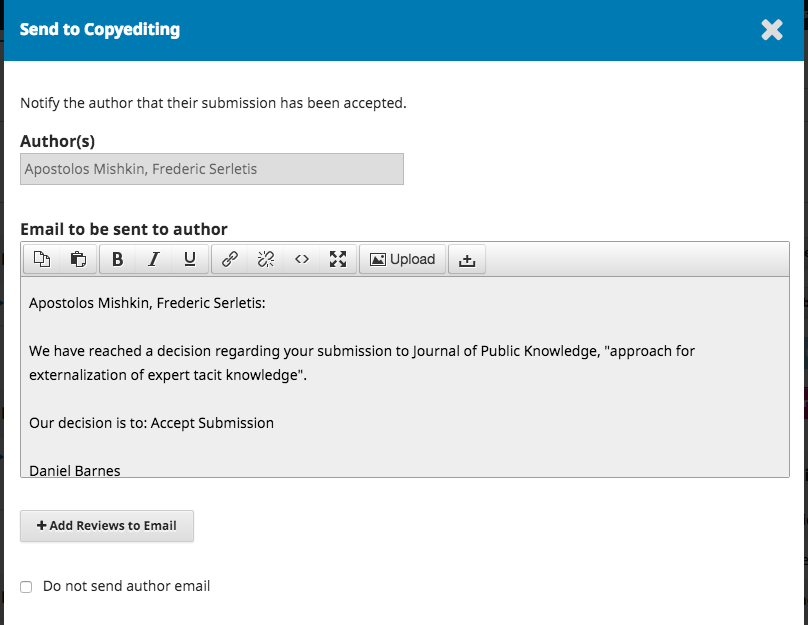
Note that if the journal has enabled an article processing charge (APC) to be charged to authors, the option will appear at this stage to notify the author that the payment is due. Selecting "Request publication fee" will prompt a payment notification e-mail to be sent to the author with payment instructions. For information most enabling author fees, delight see the Subscriptions chapter > Payment Types and Distribution settings > Enable Payments.
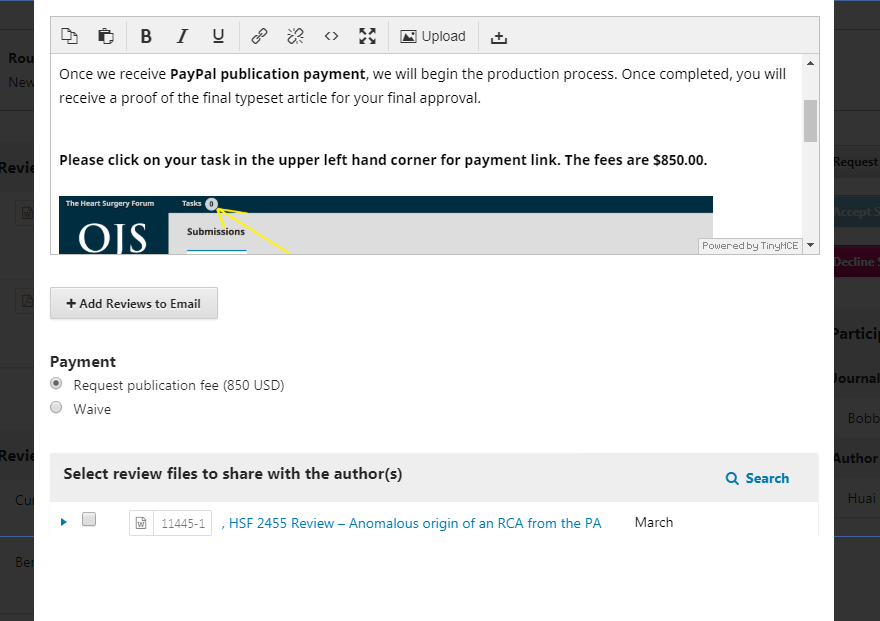
Hit the Record Editorial Decision button at the bottom of the window.
The submission is automatically moved to the Copyediting stage.
Back on the review tab, y'all will find that the status at present indicates the submission has been accustomed.

Copyediting #
This PKP School video explains the Copyediting phase. To watch other videos in this series, visit PKP's YouTube channel.
When a submission is accepted in the Review Stage, it will automatically motility to the Copyediting stage.
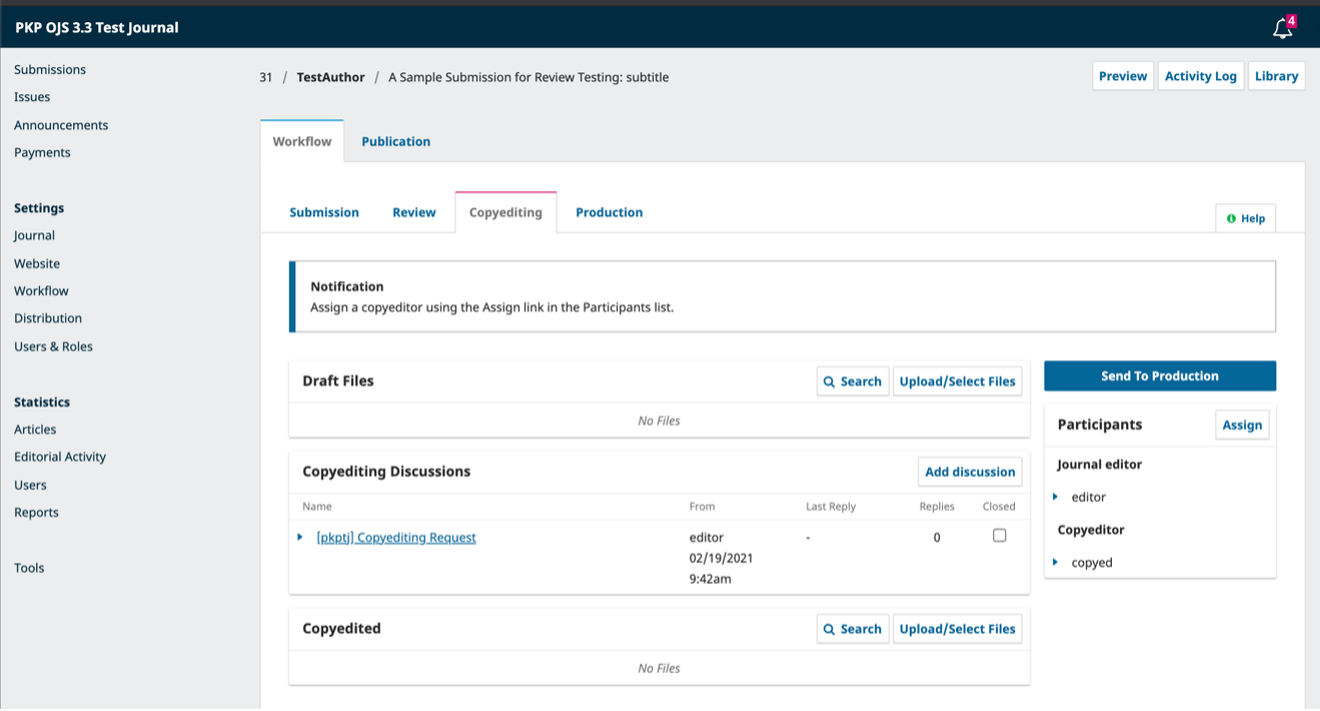
Adding a Copyeditor #
When the submission enters the Copyediting Stage, a notification indicates that a Copyeditor needs to be assigned. Copyeditors can exist assigned using the Add link on the Participants console.
This will open up a new window.
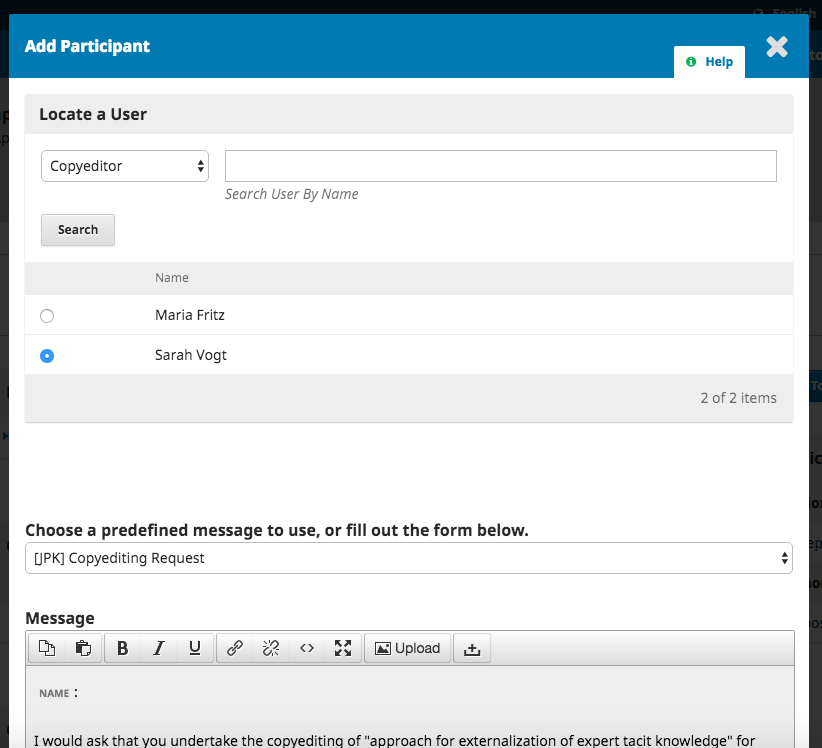
You can employ the function dropdown to cull Copyeditor and hitting the Search button. This will bring up all Copyeditors.
Select one of the Copyeditors for this submission.
Choose a prepared message.
Make whatsoever changes needed to the bulletin.
Hitting Send.
You can now run across the new notification that the submission is awaiting copyedits, the Copyeditor is now included in the Participants list, and the asking is visible in the Copyediting Discussions.
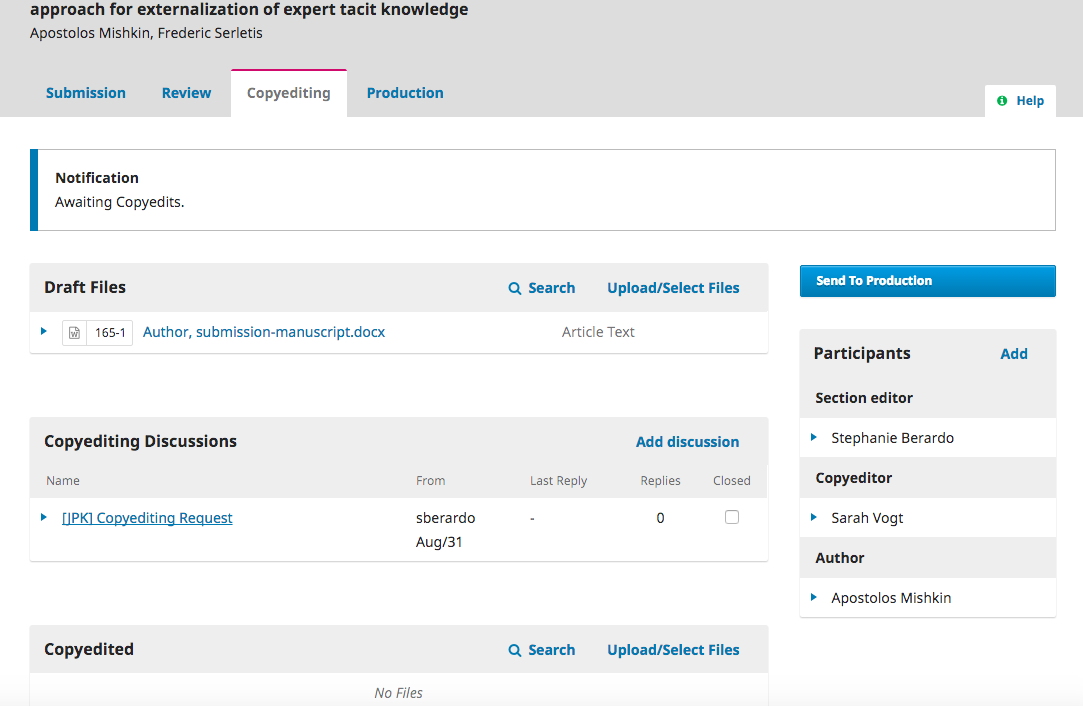
Yous tin can now wait for the Copyeditor to practise their work.
Copyeditor #
The Copyeditor will receive an email bulletin from the Section Editor requesting them to take on the submission.
To get started, they must login and notice the submission from their dashboard.

Then, they tin click the Copyediting link next to the submission proper name. This volition take them directly to the Copyediting stage for this submission.
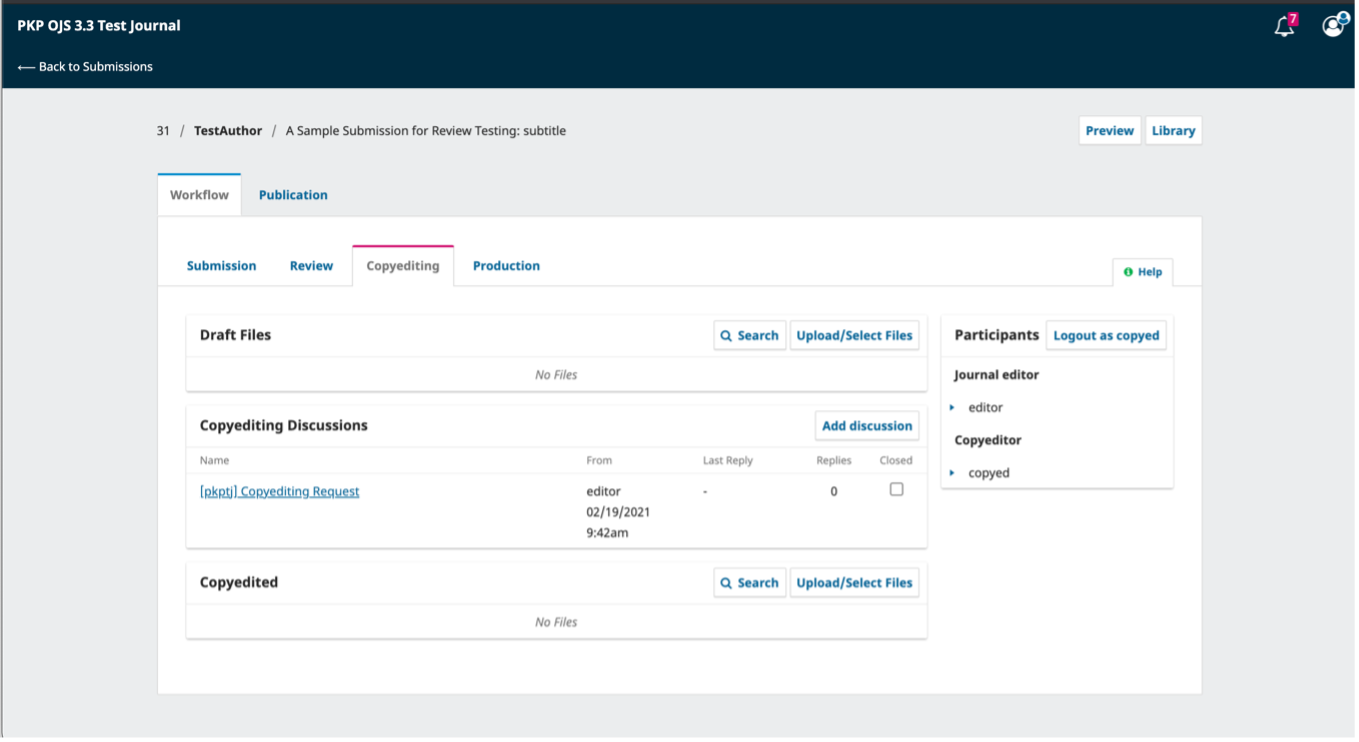
From here, they can encounter the Draft Files. These are the files that require copyediting. Clicking on the linked championship will download the file to their desktop.
Outside of OJS, they will do the copyediting piece of work.
To check the submission metadata, click from the Workflow tab to the Production tab.
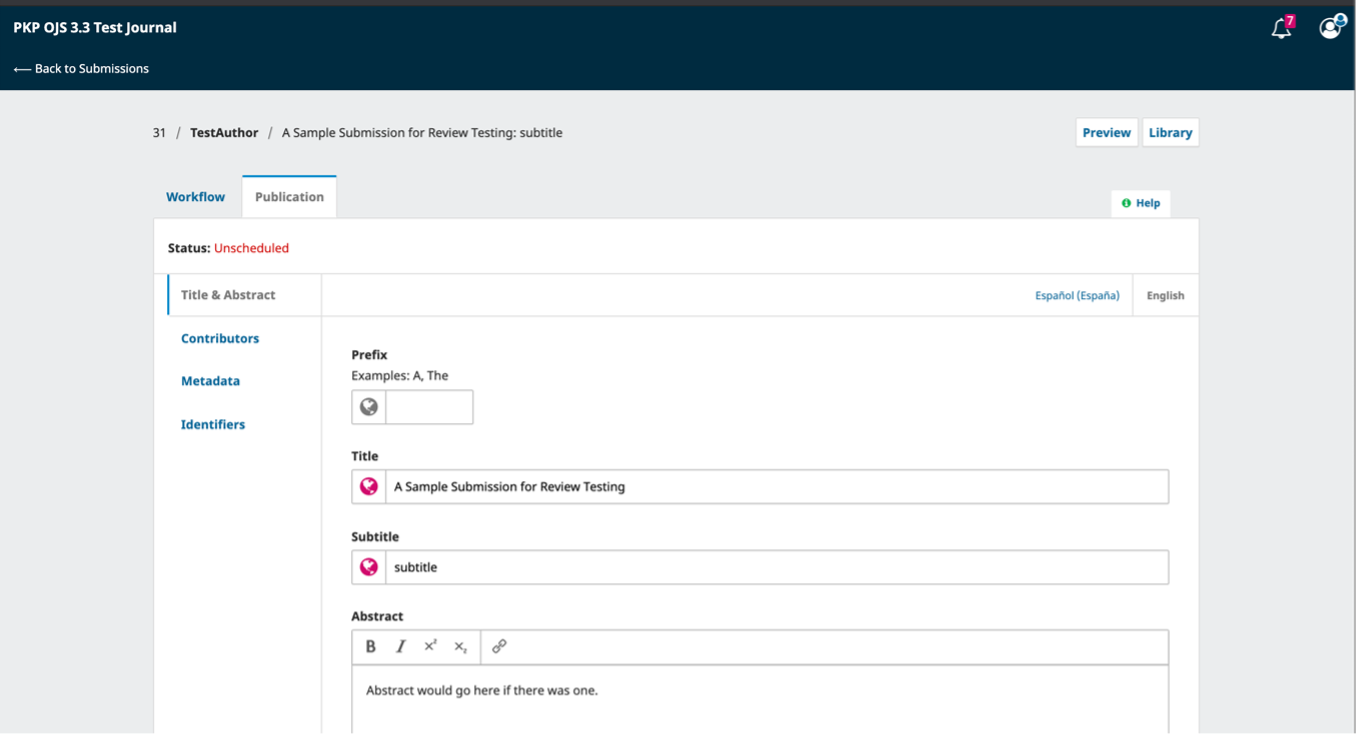
This would include checking the article championship, abstract, contributor names, keywords, etc.
If whatever changes are made, hitting the Save button before exiting this window.
Y'all can Preview how the Abstract folio would look if published with the current metadata by clicking on the Preview push button in the top-right portion of the folio.
Consult with the Author #
One time they have finished copyediting, they will run the changes past the Author past adding a new give-and-take, using the Copyediting Discussions panel'southward Add give-and-take link.
From the Add Give-and-take window, they must choose the Writer and add a discipline line and bulletin.

Further downwards that same window, they must upload a copy of the copyedited file.

To do so, utilize the Upload File link. This will open up a new window where you must choose the Article Component (east.k., commodity text) and upload the file.
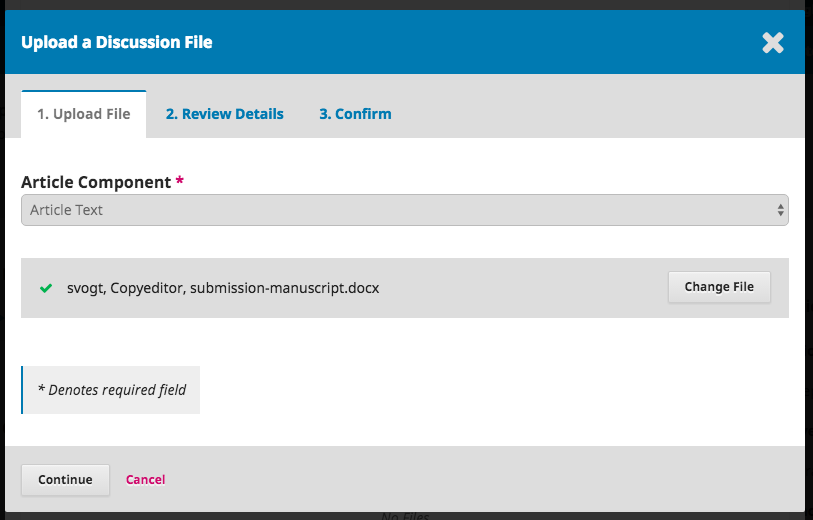
Hit Continue to go along.
This volition open the next step, where you lot tin edit the filename if needed.
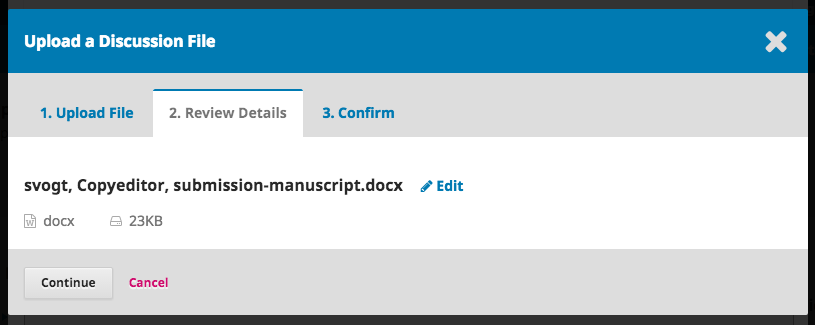
Next, you can upload more files if necessary, or striking Complete.
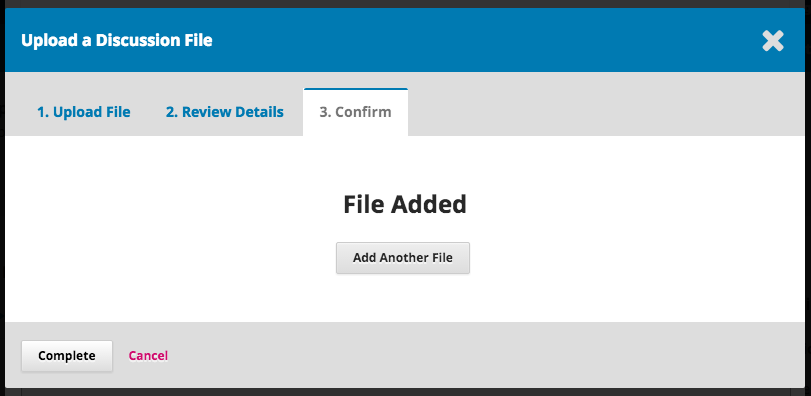
Back on the Add together window, you tin now see the attached file.

Hit OK to ship the message to the author.
It is now visible in the Copyediting Discussions.
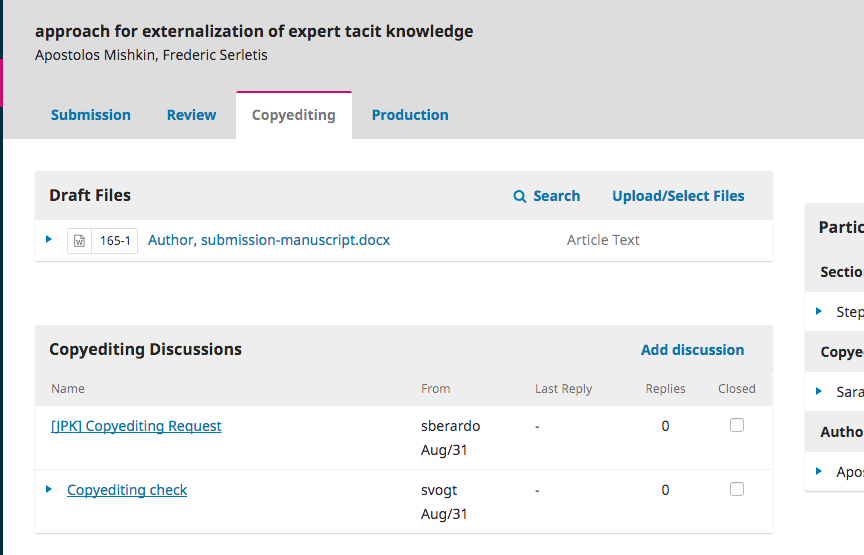
Y'all tin now await for the author's response.
In one case you hear back from the author, you lot tin review their feedback past checking the discussion reply.

From here, you can encounter no further changes are required.
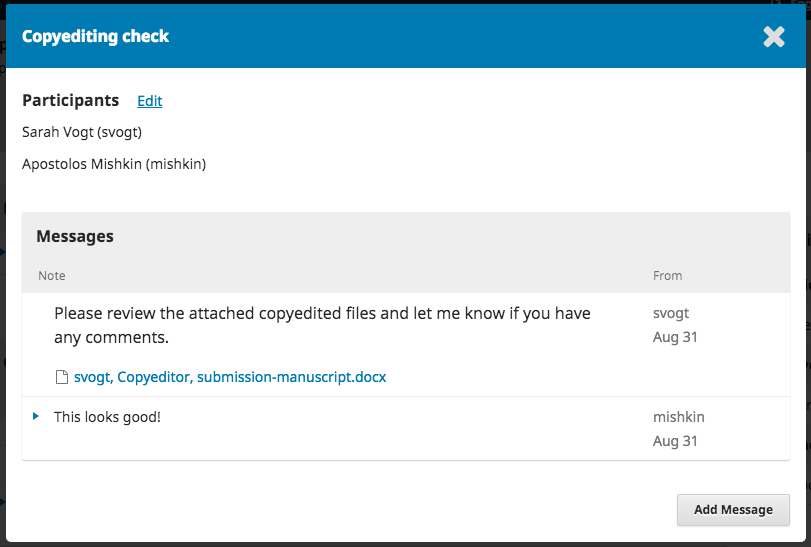
The Terminal Copyedited File #
Now y'all tin can go ahead and upload the last copyedited version to the Copyedited panel, near the lesser of the screen.
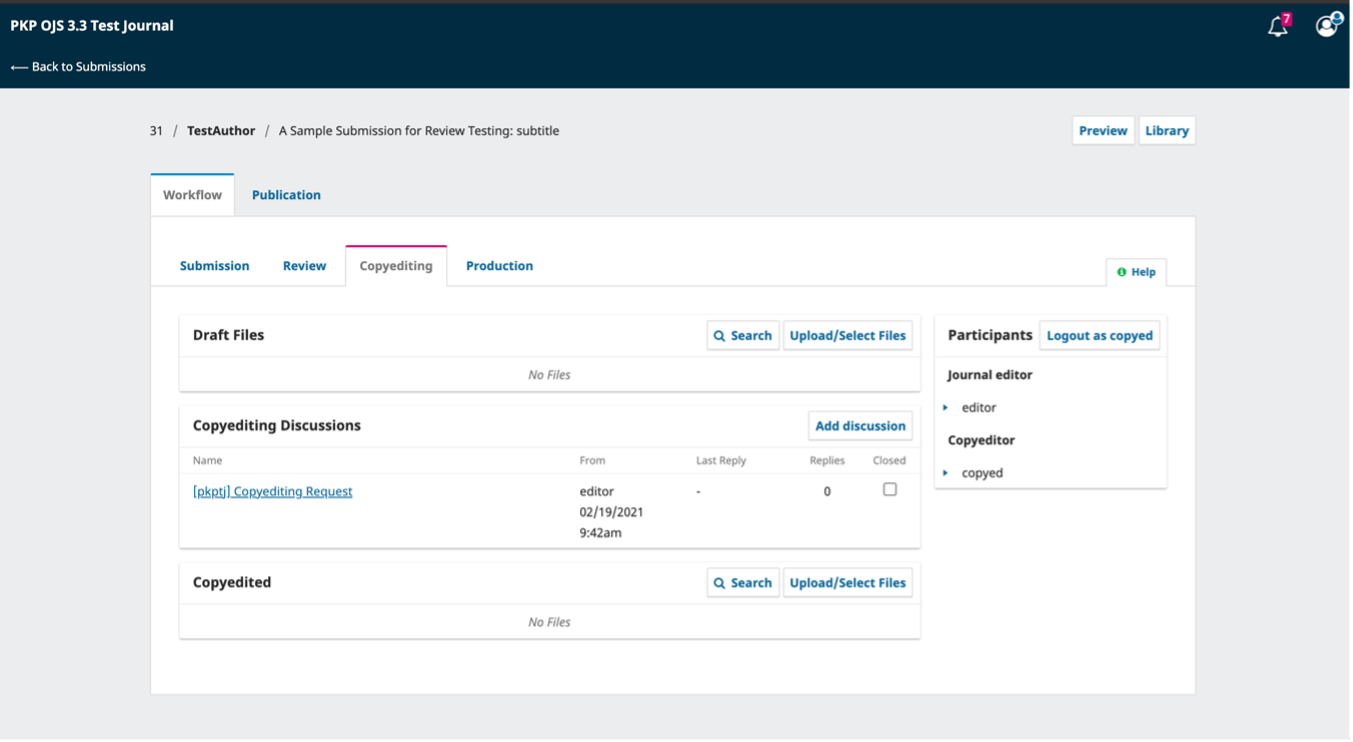
Utilize the Upload/Select Files link to upload the terminal copyedited version.

Information technology is of import to note here that you have a few choices.
- You tin can use the Upload File link to upload a new file (e.one thousand., a file with some recent changes since you showed it to the author).
- You tin can select the Writer'southward original version (unlikely).
- You tin can select the Copyeditor version, which is the version yous sent to the author (if y'all fabricated no further changes, cull this ane).
For this demonstration, we will select the Copyeditor version by checking the box to the left of that file.
Hitting OK.
The file is now visible in the Copyedited console (near the bottom of the screen), indicating to the editor that this is the final version, which is ready for the Production phase.
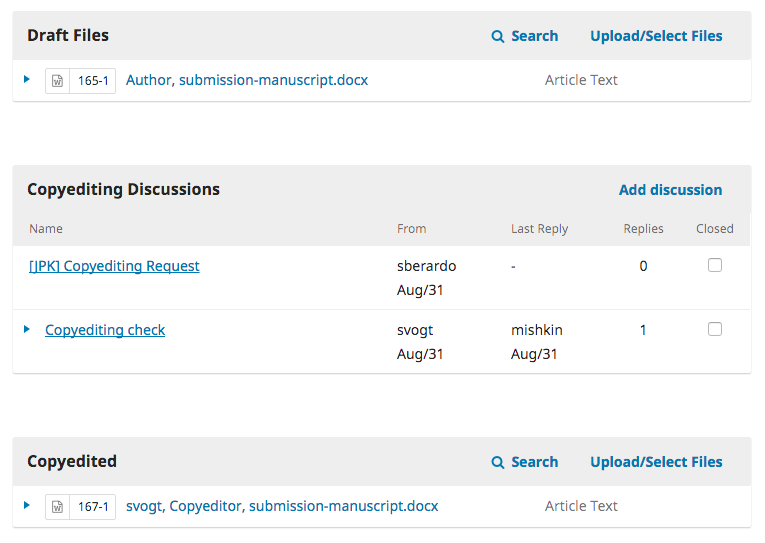
Inform the Department Editor #
The final step is for you to inform the Section Editor that the copyediting is complete.
To practice so, start a new Copyediting Discussion by using the Add Discussion link.

In the discussion window, add together the Section Editor, a subject field line, and a message.

Striking OK to send the bulletin.
Returning to the Copyediting stage, you tin can see the message is posted.
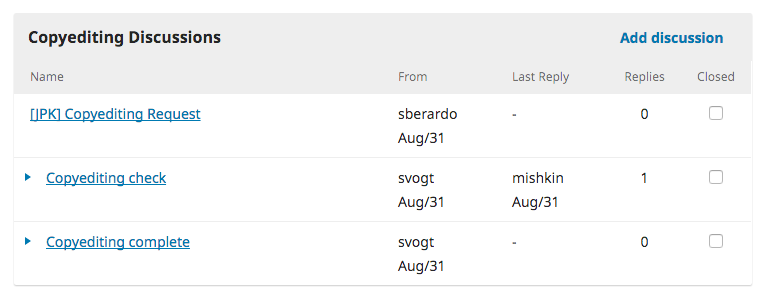
Your work as the Copyeditor is now complete!
Moving to Product #
The Section Editor will receive an email that the copyediting is complete, and run across a notification in the discussions.

You lot can download and review the final copyedited version from the Copyedited console.

At this indicate you could communicate further with the Copyeditor, or, if you lot are satisfied, move the submission to the Production stage.
To do and then, select the blue Send to Production button.
This will generate an official detect to the Authors that the submission is moving to the next stage.
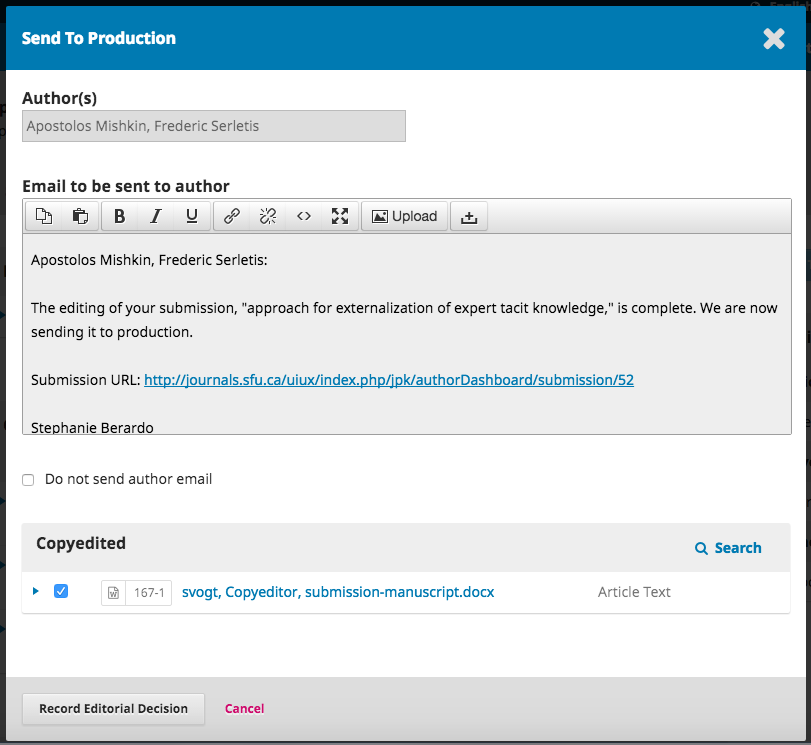
Notice that the appropriate file, from the Copyedited console, is included and volition be automatically transferred to Production.
Hit Record Editorial Decision to proceed.
The Copyediting phase is at present complete and the submission condition will be updated. The next chapter covers the Production and Publication phase.
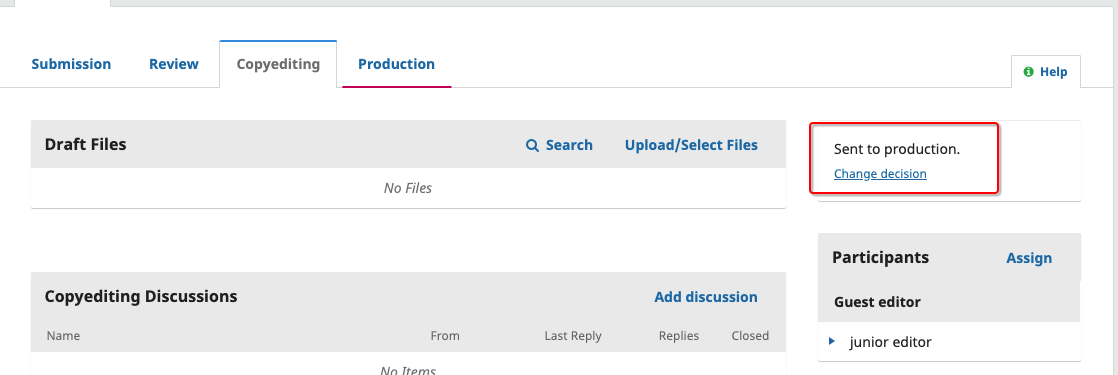
Source: https://docs.pkp.sfu.ca/learning-ojs/en/editorial-workflow
0 Response to "Which of the Following Choices Is a Component of the Reviewing Process?"
Post a Comment